






A letter to UC President Michael V. Drake demands action regarding recent national immigration policies
BY EMME DUNNING features@theaggie.org
As fear surrounding national immigration policy grows for many, faculty across the University of California system have put effort into supporting impacted students.
Tis was refected in a letter to UC President Michael V. Drake on Jan. 17, 2025 — signed by over 750 UC faculty members — calling on Drake’s ofce to take specifc steps to support undocumented students and their families.
The letter outlines the proposed federal policies regarding immigration, specifcally expressing concern for the impact new policies may have on University of California students across the state. In response to the proposed immigration rhetoric outlined by the Trump Administration, a large group of faculty has called on Drake to take fve steps to support impacted students, according to the language of the letter:
1. “Publicly reaffirm the UC’s unwavering support for its immigrant students.”
2. “Invest significant additional funds into the existing programs of support for immigrant students.”
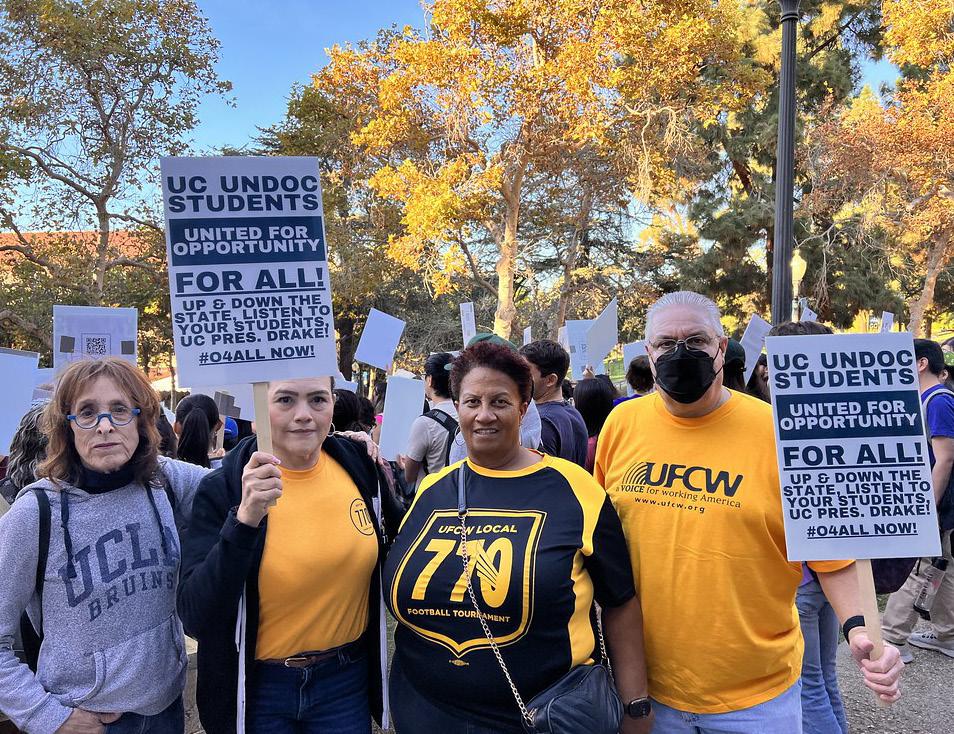
3. “Create a new program to provide emergency funds to immigrant students.”
4. “Commit to increasing student data privacy.”
5. “Provide clear guidance to campus community members, including administrators, faculty, staff and students about best practices for supporting and protecting immigrant students.”
Dr. Robert Irwin, the deputy director of the Global Migration Center and a professor in the Department of Spanish and Portuguese at UC Davis, decided to be a part of the letter. Tis decision was made to show solidarity with impacted members of the UC community, as well as to assert the importance of implementing formal guidelines to faculty members regarding
As blood shortages grow, organizations across Davis host numerous blood drives to encourage donation
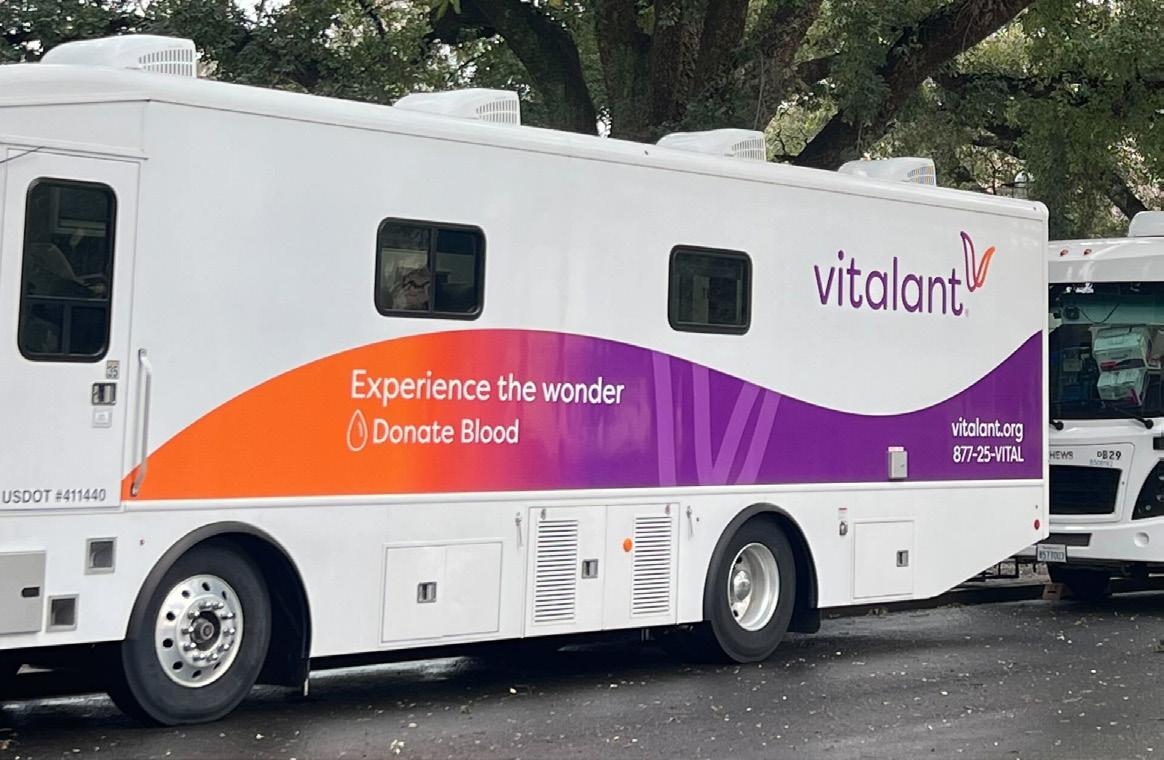
Tis February, organizations across Davis are hosting several blood drives throughout the month. Tis month alone, over 10 diferent blood drives are taking place with a large concentration of drives around Valentine’s Day.
Many of Davis’ blood drives are hosted by Vitalant, a non-proft blood collection agency. Tese drives typically take place on UC Davis’ campus, their blood collection ofce or at local organizations the drives partner with like the Davis Odd Fellows, a social welfare and fellowship-focused fraternal organization. Nationwide, many organizations, like Vitalant, strive to encourage donations during this time of year. Colder weather patterns typically decrease blood donations especially due to seasonal illnesses. However, it can be one of the most important times to donate as hospitals have a low supply and high need of blood as they are faced with seasonal accidents and illnesses.
As February blood shortages are growing, Vitalant aimed to decrease the severity of these problems through a three-day blood drive event. Vitalant hosted three UC Davis campus blood drives the week of Valentine’s Day on Feb. 12, 13 and 14. Tey encouraged students to attend and donate as these drives are fueled by student donors and volunteers.
Campbell Lee, a second-year cell biology major and Vitalant’s student co-director, worked the recent campus blood drives over the past week. Also serving on the Blood Drive Committee for UC Davis’ Pre-Med American Medical Student Association (AMSA), Lee explained the unique importance and scarcity of blood donations especially as hospitals begin to run low.
“Blood isn’t like other resources,” Lee said. “We can’t take it from other animals like we do with insulin, we can’t make it in labs like medications, we can’t buy it from other countries — blood depends on people in our community to help each other. 2025 is not a blood shortage yet, but it’s becoming a possibility. If it happens, hospitals may have to start shufing around patients, canceling people’s
elective surgeries; It could really change a lot of lives.”
To increase accessibility and donations, blood can be donated all across Davis. In an efort to increase and encourage more donors, Davis Odd Fellows hosted their own blood donation event on Feb. 11. Tey typically aim to host around four to fve blood drives throughout the year that are open to the public, and this was their frst drive of the year. Teir next blood drive will take place on May 14, with more following every couple of months.
Organization-hosted or sponsored drives really help to boost the amount of blood donors banks receive. As seen with the Odd Fellows’ drives, they speak to an audience that may not have been as inclined to donate blood before the event.
Evan Bledsoe, a member of the Odd Fellows, explained how the organization’s connections help encourage more donors.
“A lot of the Odd Fellows know a lot of people in the community,” Bledsoe said. “It really helps to bring more people out to donate and spread awareness, because they know a lot of diferent people and age groups which helps to increase donations.”
Bledsoe continued by explaining the Odd Fellows’ motivation for hosting these blood drives as they strive to help out community members and those in need.
Te Odd Fellows help out in a lot of diferent ways in the community,” Bledsoe said. “For the blood drive, specifcally, they want to help out patients who need operations because there’s been a blood shortage and national crisis for a long time. Especially as less people have been donating less since [COVID-19], we really want to help get more blood out there for those who need it.”
interactions with immigration ofcials.
“We were very concerned not just about what might happen, but about the level of anxiety amongst students who might be afected,” Irwin said.
“We thought it would be important to have a strong message coming out of the president’s ofce, as well as some procedures in place in case something were to happen so that employees and
faculty would be well positioned to help our students as much as possible.”
Irwin said that although the Trump Administration has been unpredictable, it would be unprecedented to target their immigration policies toward college campuses.
“The general public doesn’t want [Immigration and Customs Enforcement (ICE)] to be going after those kinds of people,” Irwin said. “If they start making high-profle arrests on college campuses of childhood arrivals that are just trying to study, I think it would look really bad and I think it would cause them damage.”
Despite a lack of precedent for raids on college campuses, such an action would not be completely out of line with the stated values of the Trump Administration, which issued a directive on Jan. 21 allowing ICE agents to enter previously protected schools, churches and hospitals to carry out immigration enforcement operations.
A Martin Luther King Jr. Professor of Law at UC Davis, Dr. Raquel Aldana, believes that taking action against these policies now can provide security for the future.
“This isn’t a strategy of overstating the issue — I think it actually is a fairly certain landscape that it could happen at any point,” Aldana said.
UC Davis communication professor and students weigh in on staying politically informed
BY RACHEL GAUER features@theaggie.org
Following the re-election of President Donald Trump, many have taken note of the president’s close relations with key players in various technology and social media companies. Elon Musk, chairman of X, Mark Zuckerberg, chief executive officer (CEO) of Meta, the company that owns both Facebook and Instagram, and Jef Bezos, founder of Amazon, were all seen front and center at the president’s inauguration ceremony on Jan. 20, suggesting an integrated relationship between tech CEOs and contemporary American politics. With Meta’s recent decision to
both cut their Diversity, Equity and Inclusion (DEI) programs and its fact-checking program, some have inferred that these platforms may have developed a stronger right-leaning political agenda due to their relations to the Republican president. In response, some who are in disagreement with the company’s actions have opted to delete or deactivate their accounts on Meta platforms.
Nestor Perez, a second-year Russian and Italian double major, made a choice to delete the Instagram application following the presidential inauguration, an event he said sparked a connection between the Meta platform and Zuckerberg’s involvement with the government.
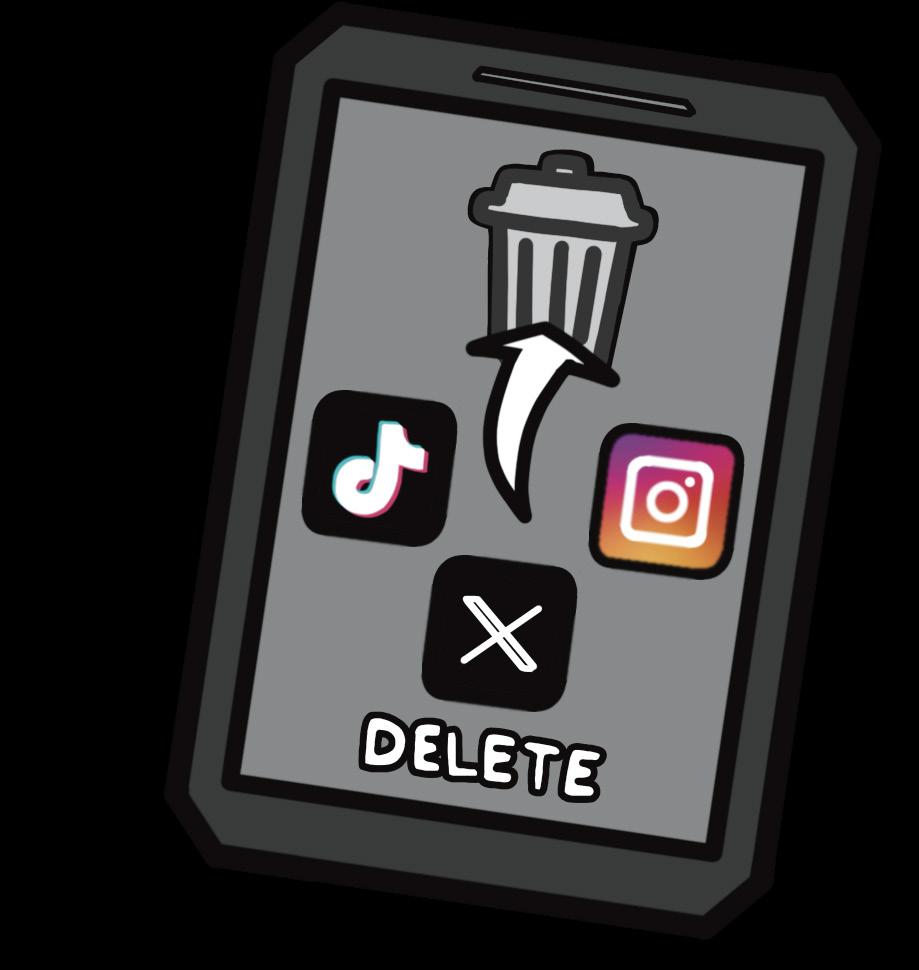
“I feel like the new presidency was what pushed me to fnally get rid of the social media that I have because it was appalling to see how these CEOs and people who run these platforms are worming their way into the government,” Perez said. “Tis is something that should not be a thing, they should be completely separate. Te fact that it is getting like this is what fnally made me say ‘no.’”
Magdalena Wojcieszak, a professor of communication at UC Davis, studies news and political information engagement through courses CMN 145 (Political Communication) and CMN 141(Media Efects: Teory & Research). Wojcieszak provided insight into the deletion of social media, commenting that though it may be benefcial to one’s mental health, it is important to strive to keep updated with the news.

The co-op revives its barbecue tradition while celebrating community and fresh food
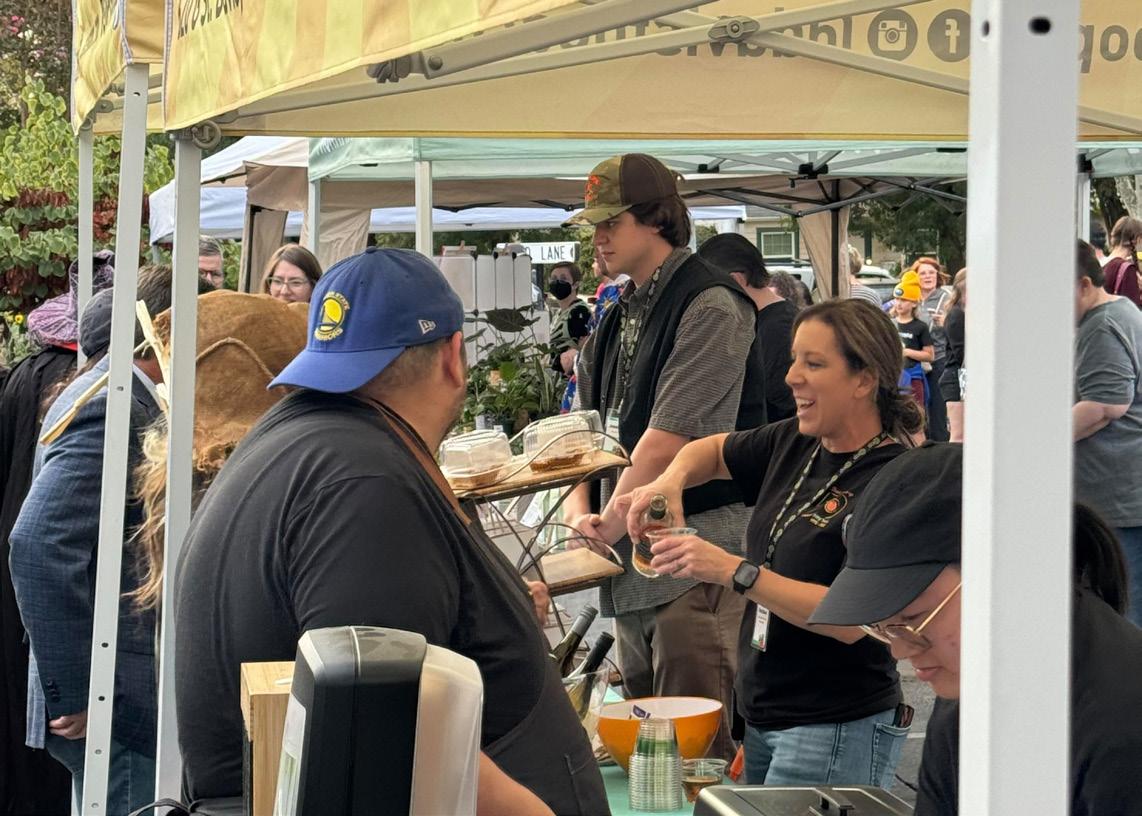
BY ALMA CULVERWELL city@theaggie.org
Te Davis Food Co-op recently hosted a three-hour Game Day Cook Out to celebrate the Super Bowl on Sunday, Feb. 9.
The Deli at the co-op offered various traditional grilled game-day favorites, including chicken teriyaki skewers, cheeseburgers, bacon-wrapped hot dogs, chili and vegan dogs, as well as classic picnic sides. Te co-op also ofered a wide selection of beer and nonalcoholic beverages. Additionally, the co-op ofered a celebratory sale on game-day essentials including 12- and 24-packs of beer, party wings, baby back ribs, chips, salsa and guacamole ingredients.
Te co-op originally started as a buying club in a living room in 1972, but over the years, it has transformed into a full-service grocery store cooperatively owned by over 8,000 local households, becoming a staple of the Davis community.
Liliana Agredano, the marketing director for the co-op, explained the longstanding tradition behind the co-op hosting barbecues and the motivation for reviving them.
“We used to do cookouts, actually way back in our heyday, like [the] ‘80s, ‘90s, early 2000s,” Agredano said. “I think it was a certain specifc day of the week. Te co-op would just have a barbeque outside and people just knew to go. We are attempting to bring it back in the best way we can. So this is kind of our frst one of the year, and we’ll likely
be doing more going forward.”
Agredano also shared the thought process behind planning their frst-ever Super Bowl event.
“We kept it quite simple for this frst one,” Agredano said. “It’s going to be hot dogs and burgers and skewers. Basically we wanted to stick to the classics of what you usually have when you’re doing a barbecue, and we do always have a vegan option. We provided vegan hotdogs, sides and a beet poke.”
It is events like this that make the co-op a beloved pillar of the Davis community. Sanjeevini Dobhal, a thirdyear biological sciences major, explained why she frequents the co-op.
“I love the co-op because of its strong sense of community,” Dobhal said. “It’s a place where you can fnd fresh, highquality food while supporting local farmers and businesses.”
Meghan Van Note, a third-year international relations major, similarly chimed in on her positive experiences at the co-op, praising their customer service.
“I love the co-op because they have the best produce,” Van Note said. “Te workers there are really sweet.”
Looking ahead into the rest of the month, the co-op has a variety of new and exciting events planned for community members. Agredano described what she is most looking forward to within the next couple of weeks.
“We have two really fun events in February,” Agredano said.
COOPCOOKOUT on 9
The Public Policy Institute of California facilitated the conversation amongst Republican representatives on California’s most pressing issues
BY RORY CONLON city@theaggie.org
The Public Policy Institute of California (PPIC) hosted a discussion with James Gallagher, the California State Assembly Republican leader, and Brian Jones, the California State Senate Republican leader, at the Sheraton Grand Hotel on Feb. 6. Te event, which is part of PPIC’s 2025 speaker series, covered topics like California’s future, wildfire recovery, home insurance and homelessness.
Rusty Areias, a board member on PPIC’s board of directors, introduced the event.
“One of the truly great legislators of modern California, the late speaker Bob Reddy, was asked what politicians do, and [he said], ‘Tey shape destiny,’” Areias said. “Te subject today is the future of California. In answering the questions about what awaits us, it is important to remember that history has accorded our guests extraordinary authority and responsibility.”
Tani Cantil-Sakauye, the president and chief executive ofcer of PPIC, moderated the discussion. She asked the two legislators to list the biggest issues facing Californians today.
Jones cited ongoing concerns about the rising cost of living in California and a range of current issues brought up by the 2025 Southern California fres.
“I think the two biggest [issues] for the last several years have been afordability, cost of living and public safety,” Jones said. “And then, of course, in the last couple of weeks, wildfres, insurance and recovery have come to the top as issues as well.”
In addition to the rising cost of living, Gallagher said fre prevention was another key issue that needed to be addressed.
“We have to reduce devastating fuel rates on our lands,” Gallagher said. “Vegetation, shrubs, chaparral, thinning, forested lands — those are all things that we really need to put some focus on because that is the No. 1 cause of these catastrophic fres.”
Cantil-Sakauye asked what the state could do to aid victims in rebuilding their homes in the aftermath of the fres.
Gallagher cited Governor Gavin Newsom’s executive order streamlining the California Environmental Quality Act (CEQA) and the Coastal Act regulations as a positive step forward in removing barriers to people rebuilding their homes. He said that local governments also need to work
The Davis Police Accountability Commission partnered with the Social Services Commission to discuss community resources available in Davis
BY YUENJO FAN city@theaggie.org
On Feb. 12, the city of Davis held the “Who You Gonna Call?” community informational event at the Veterans Memorial Teatre, organized by the Police Accountability Commission and the Social Services Commission.
In a free public outreach efort, city residents were invited to hear from government and non-profit organizations about local resources to help address crises or social service issues.
A total of six organizations were present: the Davis Emergency Dispatch Center, Davis Community Meals and Housing, the Downtown Streets Team, Yolo County Department of Health Services Agency, Davis Social Services and Housing Department and the National Alliance on Mental Illness (NAMI) Yolo County.
Assistant City Manager Kelly Stachowicz touched upon why the city decided to host the event and the importance of residents having diferent ways of fnding help.
“Every year, [the commissions] try to put on a public outreach event to help people understand law enforcement or [their] alternatives,” Stachowicz said.
Te purpose of this event was: if people are in crisis or they have a particular issue where they need assistance of some sort but it might not be a criminal issue, [...] who do they call? What resources do we have in the community? [...] A law enforcement ofcer may come out, but somebody else is going to be the one who’s going to be trained to deal with the mental health issue or homeless outreach, etc.”
Stachowicz emphasized how different crises warrant different responses and that Davis has the necessary resources specifc to all types of non-criminal issues that could arise.
For instance, the Davis Social Services and Housing Department is responsible for issues regarding housing and homelessness, focusing on promoting community health and safety.
Dana Bailey, the department’s director, spoke on how the department aids community members currently struggling with homelessness.
“What we attempt to do is to go out, boots on the ground, and engage with people that have experience of being unhoused on the street,” Bailey said. “So, our team of two will go out in response to calls from the community and try to talk with someone that is either in crisis or just living on the street and try to connect them to some form of services.”
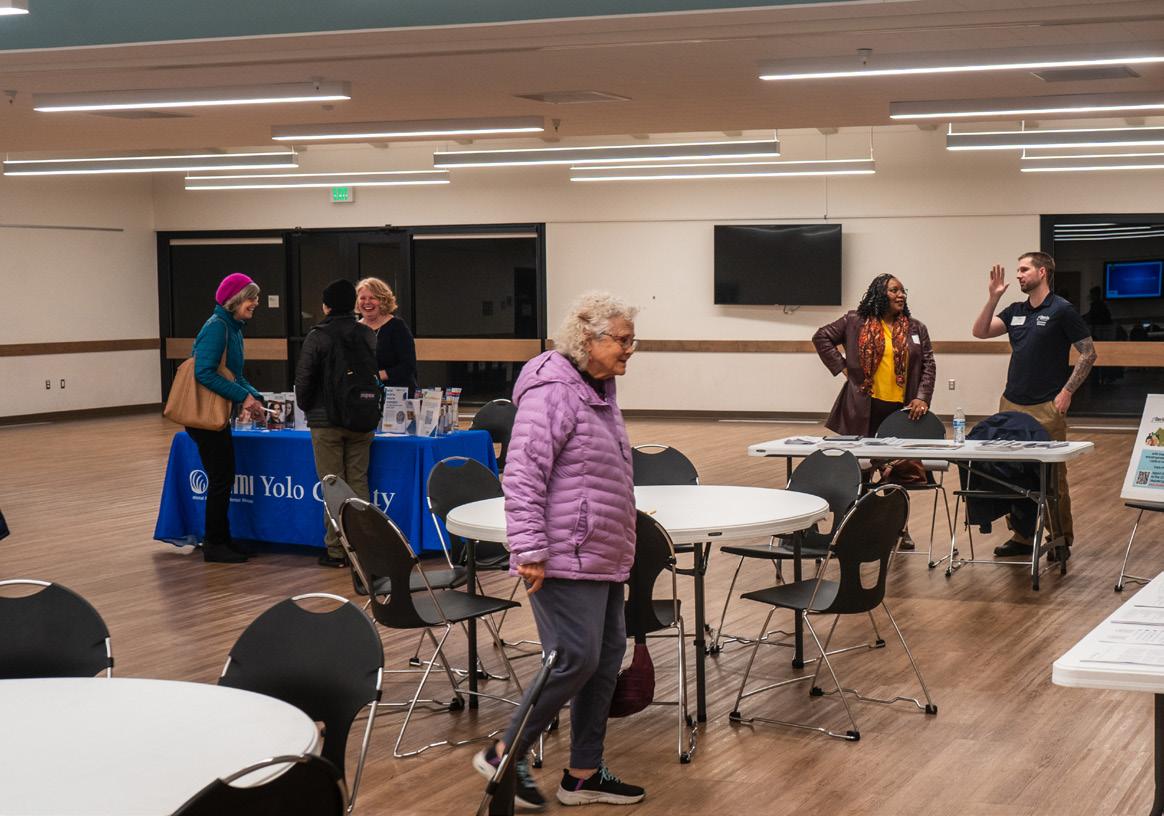
event.
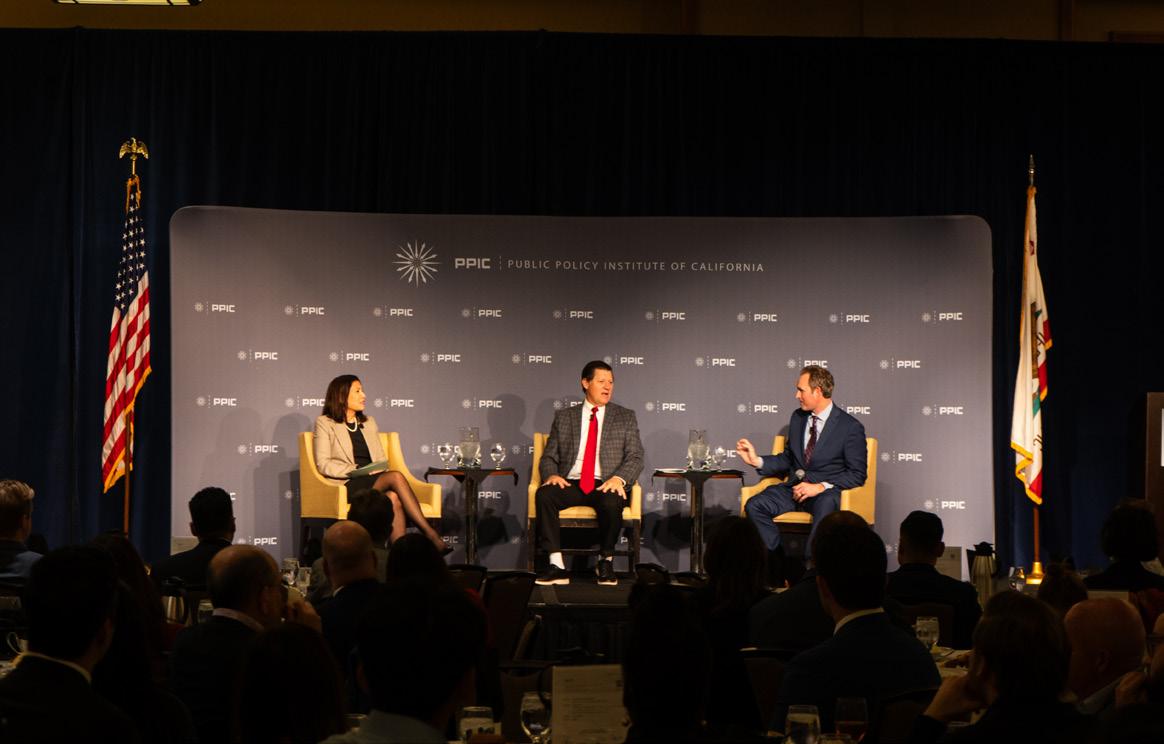
with non-proft organizations to provide more aid.
“You probably don’t have enough public staf at the building inspection ofce to handle permits,” Gallagher said. “You’re probably going to need to utilize the public sector non-profts and [see] what they can bring to the table. I think it’s going to be a huge thing, because there are so many things the government just can’t cover, and non-profts could step in and help with recovery.”
Jones said ofcials needed to be held accountable for mistakes they made in fghting the fre.
“Why was there no water in a fre hydrant?” Jones said. “Why are fre hydrants being stolen? Why were the fre trucks not able to get to where they needed to be? We all should expect accountability from our government.
An elected ofcial or appointed person made these decisions that exacerbated and made the wildfre worse, and those people need to be held accountable.”
Discussion turned to how the legislature could stabilize the home insurance market in California in light of recent fres. Jones said the problem lies in over-regulating the home insurance market.
Te legislature telling insurance companies what they have to cover, in my opinion, is a command and control economy that is inappropriate for a freemarket system,” Jones said. “We need to back of the regulations a little bit and give the insurance commissioner more authority [...] and then bring the insurance companies to the table and tell us what they need to stay in business. Not one single person in California benefts if one insurance company leaves the market.”
Gallagher said the state should also
mitigate risk for insurance companies by conducting prescribed burns and thinning in certain locations.
Te governor and the president, a while back, came to an agreement where they said they were going to [burn] 500,000 acres a year,” Gallagher said. Tey haven’t even come close. In fact, the governor got caught in a lie a few years ago when he said he did 90,000 acres and it turned out he really did 11,000 — the bottom line is, we haven’t been doing the job.”
Cantil-Sakauye asked what the legislators would do to help the 180,000 unhoused people in the state. Gallagher alleged that, as of last year, the governor’s ofce has not been collecting metrics on the money spent by non-profts and government agencies to combat homelessness. He said that instead of taking a top-down approach, the state should have local regions submit their own plans for addressing the issue.
“We already have counties and local governments who do a lot of great work getting people connected to resources,” Gallagher said. “And then we fund regional plans that have been brought together, as opposed to just sending out money and saying, ‘I hope they spend it well.’” Gallagher said the state also needs to change its strategy to empower people out of homelessness.
“Some of the policies have changed,” Gallagher said. “We’re saying, ‘Look, some people with severe mental illness, for example, you have to get them of the street and get them medicated, and that requires conservatorships.’ We supported that legislation. It was actually bipartisan to fnally do that.”
The monthly production is thriving in its new era: “Second Sundays at Sudwerk”
Non-proft organizations such as the Downtown Streets Team also seek to aid those experiencing homelessness by providing jobs and a sense of belonging. Tose who are experiencing homelessness can use this as a resource to fnd ways to seek assistance and employment.
Heather Mundy, the director of Downtown Streets Team Sacramento and Yolo County, provided a deeper dive into what the organization does.
“We want to work with people who are in the experience of homelessness and we want to help them feel included in a community,” Mundy said. “So, you may see our team members in yellow shirts. [...] Tey put those on and they know that they belong somewhere and that they are part of the team. Our volunteers then go out, pick up garbage and they beautify the community. Tey have picked up a lot of garbage in Davis so far.”
Moreover, presenting mental health resources was also another large part of the city’s outreach event. NAMI Yolo County has an array of programs and public awareness initiatives that hope to inspire change. Founded in 1979, NAMI has grown into a nationwide non-proft that holds more than 600 afliated programs and continues to be a trusted support outlet for those struggling with mental illness.
The organization’s Executive Director for Yolo County, Jen BoscheeDanzer, believes that NAMI is a place where those struggling with mental illness can go for support.
“All of our programs are ofered at no cost to participants and everything that we do is peer-led,” Boschee-Danzer said. “Our mission at Yolo County is to provide advocacy, support, education and public awareness so that all individuals and families who are afected by mental illness can build better lives.”
The “Who You Gonna Call?” community informational event is held annually and sponsored by the city of Davis, the Police Accountability Commission and the Social Services Commission. More information on other upcoming events can be found on the city of Davis’ website.
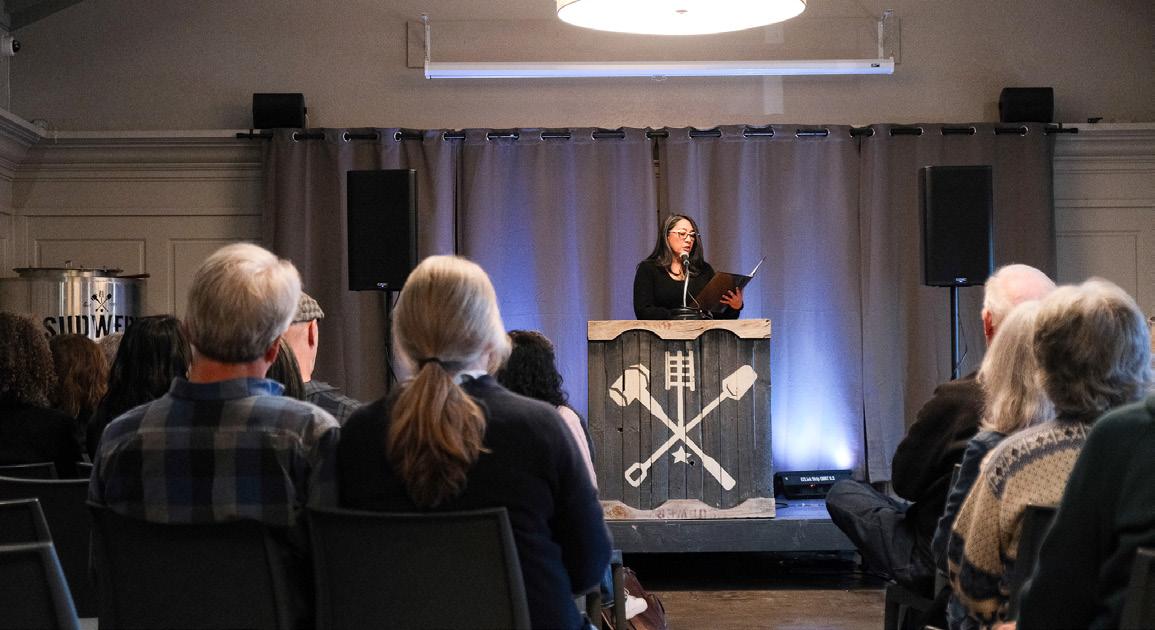
A guest speaker reads stories aloud at the Stories on Stage event. (Christian Cendejas / Aggie)
BY OLIVIA HOKR city@theaggie.org
On Feb. 9, Stories on Stage Davis (SOSD) held its monthly reading event in the Sudwerk Brewery Co. Beer Hall. Te productions were previously held in an art gallery, but due to increased popularity, they recently switched over to Sudwerk.
Maya Sinha is the Season 11 director of Stories on Stage Davis. She shared the purpose of the Stories on Stage organization and its development over time.
“Stories on Stage Davis is an allvolunteer, non-profit organization founded by Davis resident Jeri Howitt,” Sinha said. “Starting with Howitt, who remains the founding director, SOSD has had a series of local writers as directors over its 11 seasons.”
Sinha explained their need to move to a large space due to the successful growth they have had over time.
“For its frst 10 seasons, SOSD’s monthly readings were held at the Pence Gallery in Downtown Davis, a fruitful collaboration in the local arts community,” Sinha said. “In September 2024, needing more space for our growing audience, we moved the readings to Sudwerk Brewery’s Beer Hall for Season 11. We’re very happy with the new space and increased turnout this year.”
Each month’s production brings a diferent energy to the stage, with some stories on the humorous side and others more emotion-provoking. For the
February event, the production focused on fash fction, which is a story that is limited to a small number of words. Kat and Matt Miller, a husband and wife acting duo, read stories by Hema Padhu and Grant Faulkner, respectively. Kat Miller read “Te Pea Tat Changed Everything” and “Unremembering.” Matt Miller read “Invocation to Possible Angels” and “Cold Hard Cash.” Sinha shared insight into the intricate process the organization goes through each month to choose authors and actors and put together a successful and entertaining reading performance.
“Howitt, a voracious reader, takes the lead on choosing stories for each season, in consultation with the seasonal director,” Sinha said. “With some exceptions, we look for writers in Davis, Woodland, Sacramento and the Bay Area, whose pieces would present well for an audience. We aim for authors with a wide variety of backgrounds, ages and styles, including some nonfction.
Once the stories are selected, Casting Director Tim Gafaney draws from a diverse group of regional actors and casts a performer suited to each piece.”
Stories on Stage holds their events on the second Sunday of every month from September until May, beginning at 4 p.m. Te readings are free, though they provide the option to give a $5 donation. Te organization aims to provide a space for showing support for local writers and performers while socializing and enjoying dinner or a drink.
SR#7, which had support from attending members of the public, was saved for a later date over concerns that not all stakeholders were consulted
BY VINCE BASADA campus@theaggie.org
Te ASUCD Senate indefnitely tabled a resolution on Thursday, Feb. 13, affirming protections for undocumented students over concerns from ASUCD President Gaius IIupeju that not all relevant stakeholders had been consulted. Many members of the public who attended the meeting spoke in favor of the resolution, though some criticized its language as overly political and divisive.
Senate Resolution (SR) #7 aims “to serve as a direct response to the racist and xenophobic Trump administration.” It called on the university to “adopt and implement policies that designate the university as a sanctuary campus,” including but not limited to forbidding University of California police departments from complying with federal immigration agencies, guaranteeing privacy, supporting international scholars and staf, restricting the use of excessive force and expanding services for marginalized communities.
SR#7 also called on Davis City Mayor Bapu Vaitla and California Governor Gavin Newsom to reafrm sanctuary status for the city and state, respectively. Davis was originally declared a City of Sanctuary in 1986; California became a sanctuary state in 2017.
Te resolution was authored by Sandy Saens, a legislative director for the ASUCD, and lists Senate Pro Tempore Dhilena Wickramasinghe as a co-author.
Tis is not necessarily a call to action,” External Afairs Commission (EAC) Chair Henry Rosenbach said of the non-binding resolution. “It’s more of an embrace and a certainty that things are going to be all right even in times of uncertainty.”
ASUCD resolutions express, according to internal bylaws, “the views of the [Association’s] membership” including “stances on city, county, state, and national political legislation and issues.” If passed, copies of SR#7 would have been sent to UC President Michael V. Drake, the UC Regents, UC Davis Chancellor Gary May, a cadre of other university ofcials, leaders of the city of Davis and the press.
Several members of the public additionally addressed the Senate in support of SR#7, noting the need for support from student ofcials.
“Everybody deserves the right [to] an education,” Maya Lopez, a frstyear political science — public service
major, said during the meeting’s open comment section. “A lot of students and faculty [are] of immigrant status and they just want a better life. We just need a better life.”
Luis Garcia, a second-year political science major and former ASUCD interim senator, echoed this point.
“No student should have to live in fear or uncertainty simply because of their immigration status,” Garcia said.
Tese students are our classmates, our friends and a crucial part of this community. I understand there might be some language in the resolution that some of you might not agree with, but don’t let that take away from the bigger picture.”
Not everyone at the meeting agreed with the merits of SR#7. Daniela Lurey, a fourth-year environmental policy and planning major, spoke against the legislation on behalf of the Davis College Republicans (DCR), of which she is the co-chair.
“The resolution is legally unenforceable, fnancially unsustainable and politically driven,” Lurey said.
“[SR#7] con f icts with federal law, which risks UC Davis’ funding, and it demands policies that are beyond the authority of the university. It promotes selective law enforcement, which could create potential security risks and jeopardizes campus safety.”
Lurey and the DCR also took issue with the resolution’s description of the current presidential administration as “racist and xenophobic.”
Ilupeju and others pointed out that the requested protections for students conveyed in SR#7 are an extension of existing ASUCD practices and previously stated values.
Tat said, while Ilupeju agreed with the resolution’s sentiments and support of undocumented and international students, he criticised the bill for not being researched enough and called out EAC, who had reviewed the resolution, for its failure to discern between actions that ASUCD wanted to be done and those already in practice.
Te language [in SR#7] says that ASUCD calls, ‘on [UC Davis] to adopt and implement policies that designate the university as a sanctuary campus,’”
Ilupeju noted. “It doesn’t say protect and make new policies. It says ‘adopt and implement.’ If this hadn’t been pointed out, we were about to send it to the entire campus community saying that we didn’t believe that they had adopted or implemented those policies.”
“I would just implore you all to be a little bit more thorough,” he added.
Rosenbach later provided a response to these comments.
“We’re really scared and [university
leadership] hasn’t done anything out in the open, and we’re [having] to beg for information, especially for services for international students,” Rosenbach said. Tis went through my commission and my commissioners, and a lot of them are non-U.S. citizens, including myself. I apologize for the language. In our understanding, it was not as damaging as it appears to be, especially given that this is a personal stance for a lot of [us].”
Ilupeju also expressed concerns that by passing too many resolutions, the Senate was devaluing them to possible recipients. He also said that he felt that the table did not properly communicate with the resolution’s intended audience before SR#7 was drafted.
T ere’s a reason why ASUCD resolutions aren’t given much weight,” Ilupeju said. “[It’s] because we pass them all the time without having conversations with [university leaders].
When we’re appealing to them to do something and we haven’t done the due diligence of [talking] with them, what does that say about the conversation we’re trying to have with them after we pass this?”
He instead proposed writing a letter to university ofcials or making some other public statement, rather than communicating their viewpoint through legislation.
Some provided a diferent opinion on the matter, including Senator Siddharth Jasthi.
“If you know people in admin are working on these things and making progress towards them, then it does fall on them for not publicizing it and not communicating it to the Senate,” Jasthi said.
While Ilupeju acknowledged that there had been a failure in the line of communication between UC leadership and the student government on the matter (something he said he had been pressing administration on), he and Internal Vice President Aaminah Mohammad reiterated that work was indeed being done for afected student groups.
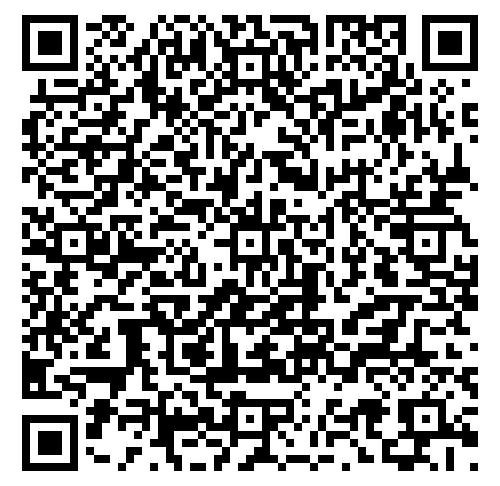
UC Davis hosts 14th annual Biodiversity Museum Day
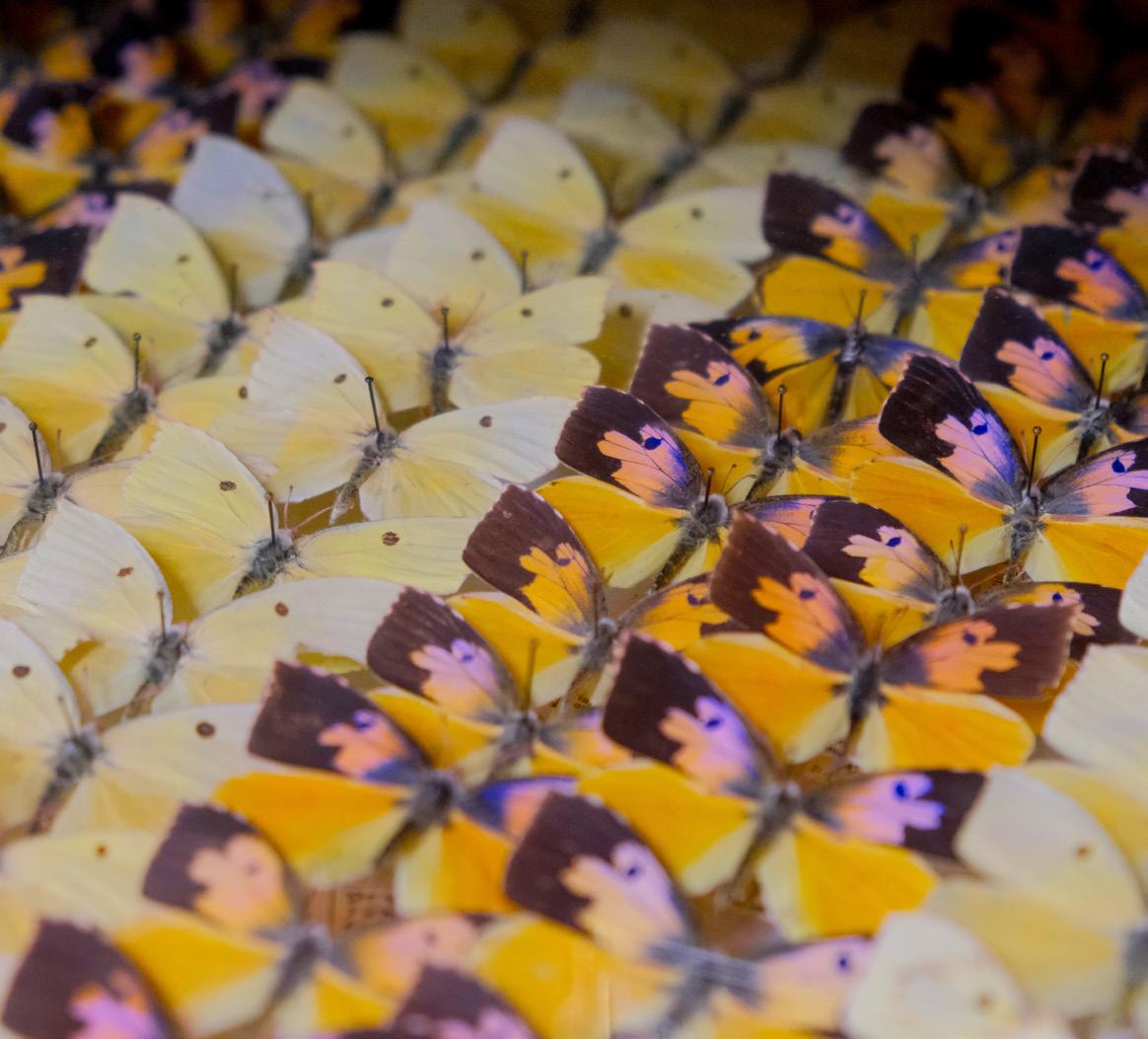
BY PIPER AWEEKA city@theaggie.org
UC Davis held their 14th annual Biodiversity Museum Day across a variety of city-wide locations on Feb. 8. Activities were held at the California Raptor Center, UC Davis Arboretum and Public Garden and the Bohart Museum of Entomology.
Tabatha Yang, the coordinator and co-founder of the event, was busy delegating tasks to university volunteers amidst crowds of children and adults. As the education and outreach coordinator for the Bohart Museum of Entomology, Yang gave background to the annual celebration.
“Bohart [Museum of Entomology] had been doing open houses on the weekend, and they were popular,” Yang said. “Ten we would collaborate with [the Department of Wildlife, Fish, and Conservation Biology] because they are our neighbors. And then we connected with the Botanical Conservatory. So one year we just did this kind of three open-house thing across campus, we were like, ‘Tis is great,’ and then it expanded from there.”
Citing UC Davis’ powerhouse in biology and ecology research, Yang elaborated on the expansive focus of Museum Day.
“We just wanted one day working together,” Yang said. “Some of the collections are living, and then some of the collections are preserved, but we’re all science collections.”
Julie Cotton, the co-manager of operations at the California Raptor Center, emphasized the center’s special contribution to Museum Day.
“Our collection is a little unique in that we’re one of the only collections where our specimens are primarily live specimens,” Cotton said. “We have a collection of non-releasable birds of prey
that serve as educational ambassadors for their species here.”
Cotton then talked more about the Raptor Center and also elaborated on its objectives and long-term goals.
“One of our big goals is to be open to the public and family-friendly, [...] we host many visiting school groups, we ofer classes and tours,” Cotton said. Tere’s a whole part of our mission that people don’t get to see as much. We also rehabilitate injured, orphaned and sick birds of prey that members of the public fnd. [...] Last year was actually a record-setting year for us, 261 birds [rehabilitated] in 2024.”
Kurt Wendlenner, an attendee at the California Raptor Center, refected on Biodiversity Museum Day’s signifcance for the community.
“It’s a great event that we try to bring the kids out to,” Wendlenner said. “It’s a great component of Biodiversity Day and showing everything that UC Davis and the Davis community has to ofer.”
Ash Robinson, a UC Davis student volunteer majoring in evolution, ecology and biodiversity, talked over the crowd inside the Bohart Museum to share about preserved fsh specimens and the success of the event.
“We keep all of our fsh in 70% ethanol to kind of preserve them,” Robinson said. “So all of them are dead. Tis is my frst time doing Biodiversity Day, but there are a lot of people who are engaged, which is very fun.”
With throngs of attendees actively engaging with displays of preserved animal carcasses and live birds of prey, Yang spotlighted the unique beauty of UC Davis’ Biodiversity Museum Day.
“We try to open our doors to the public, [...] that was the way Dr. Bohart operated as a professor — he always had an open-door policy,” Yang said. “If you go to other collections, it’s not this open. It’s highly unusual.”
ASUCD Student Health and Wellness brought together students and experts in the field to discuss reproductive health topics
BY MEGAN PUSL
campus@theaggie.org
In response to the current political climate, the ASUCD Student Health and Wellness unit (SHAW) organized a reproductive rights panel to advocate for student health and share resources.
On Feb. 6 from 10:30 a.m. to 12:30 p.m., SHAW hosted three guest speakers and highlighted various campus resources for reproductive justice. Te frst 100 students to attend received free Plan B, an emergency contraceptive.
Four diferent campus organizations tabled at the event to provide resources, including SHAW, Love Lab, Gender and Sexuality Commision (GASC) and Sexual Assault Awareness Advocacy Comittee (SAAAC).
Adeena Rahman, a third-year molecular and medical microbiology major and the director of SHAW, had a large role in planning the event. Rahman, along with the other SHAW coordinators, organized this event to provide resources for students and highlight notable guest speakers.
“Because of the current political climate, I really wanted to have an event that could help inform the student body about what is accessible to us in regards to reproductive rights and health,” Rahman said. “I brought in three speakers hoping that they could all address reproductive rights [and] reproductive injustice through diferent lenses.”

The first guest speaker was Rachel Cradit Henry, the sexual health promotion specialist at Health Education and Promotion (HEP) at UC Davis. Te second guest speaker was Mitchell D. Creinin, the director of the Complex Family Planning Fellowship in the Department of Obstetrics and Gynecology at UC Davis.
Creinin covered many topics in the scope of reproductive healthcare during his talk. He taught the audience about the process of In Vitro Fertilization (IVF), types of emergency contraceptives, such as Plan B and Ella, and the process of getting a male birth control approved for the public.
Creinin stressed the importance of legislation as it pertains to reproductive rights.
“It’s all about who you vote for and who you put into power, that’s really the issue,” Creinin said. “Te short term is to make sure you’re protected, make sure your friends are protected [and] have emergency contraceptive around. But the long game is always gonna be voting.”
Te third and fnal guest speaker of the day was Essential Access Health’s Public Afairs Coordinator Melody Yan. Essential Access Health is a non-proft based in Berkeley and Los Angeles that works to advance reproductive equity for all.
Yan shared her experience working in public policy, speaking about reproductive health laws in California with a focus on minor confdentiality and teen rights laws. She emphasized

the importance of youth having access to trusted adults with whom they can discuss topics like birth control, sexuality and sex, noting that many minors lack this support.
“Tat is the reality for a lot of young people and teens,” Yan said. “Tey don’t have that openness and safety with adults. Tat is why minor consent laws play a huge critical role in empowering young people to make decisions about their healthcare.”
Next, Yan highlighted past California legislative victories within her non-profit that contributed to protecting and expanding contraceptive and abortion care in recent years. She mentioned grant programs that Essential Access Health administers for California such as Los Angeles Abortion Safe Haven, Uncompensated Care and Practical Support.
Yan explained the importance of maintaining funding for these grants to protect reproductive rights.
“We cannot forget the importance of maintaining this infrastructure we’ve created in California ensuring that people in the state and people who really need to come here can get the care,” Yan said.
For anyone who wishes to fnd out more about SHAW, you can visit their Instagram account, @asucd.shaw. To keep up with events hosted by the other student health resources featured at the panel, you can follow their accounts on Instagram: @asucd_gasc, @asucd_saaac and @ucdlovelab.




How dangerous political rhetoric works to normalize the mass deportation of undocumented Latino immigrants
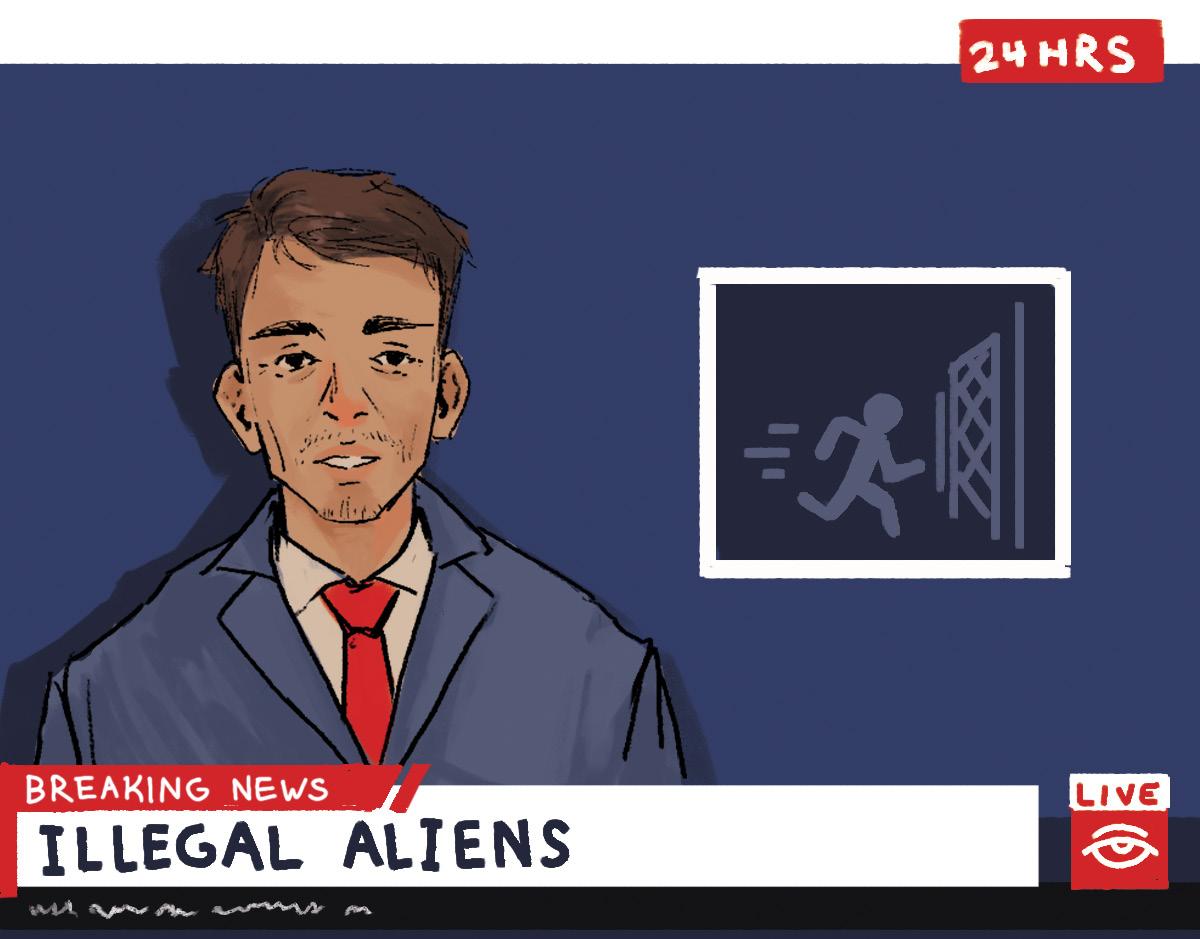
BY TARA ROMERO tcrome@ucdavis.edu
“Illegal aliens.” It’s a phrase that already feels like Propaganda 101, and yet it’s plastered across news outlets and feeds throughout the country.
With President Donald Trump’s return to ofce, dehumanizing rhetoric has circulated in the news and on social media in an attempt to justify the mass deportation of undocumented Latino immigrants. Although Trump has only been in ofce for a month, he has already passed over 20 diferent executive orders that directly target undocumented Latino immigrants.
It’s unsurprising that “illegal alien” is the term that the United States Immigration and Customs Enforcement (ICE) uses throughout their website to refer to undocumented immigrants — unsurprising in the same way that their three enforcement subheaders are “arrest,” “detain” and “remove.”
Te words our own government offices and officials use to label undocumented immigrants are intentional and harmful. Language is a powerful source of manipulation. Simple things like word choice can be extremely loaded — particularly when used against marginalized groups of people.
Dehumanizing language works in many ways, but specifcally in labels. Te most explicit form of dehumanization is to reduce a person or group to an animal or object. Just in April of last year, in a campaign speech, Trump himself provided us with an example of this type of harmful language against undocumented immigrants:
“No, they’re not humans,” Trump said. “They’re not humans; they’re animals.”
However, dehumanizing language can also be more subtle. Another word that is being thrown around
to label undocumented immigrants is “criminal.” Without the proper context, “criminal” may not seem like dehumanizing language at all. However, “criminal” has a history of racialized violence associated with it. In her work
Te Racialization of Crime: A Brief Genealogy,” Miranda Pilipchuk tells readers how criminality appears to be a race-neutral term, even though it has historically targeted people of color.
Furthermore, Education Initiatives Manager at College and Community Fellowship Lisette B. Hughes drew from her own research and personal experience as a formerly incarcerated person to discuss how words like “criminal” and “convict” dehumanize incarcerated people. She explained how these words essentially justify mistreatment and the withholding of basic human rights within the U.S. prison system. Tey defne incarcerated people as no longer people and instead refections of whatever “crime” they are associated with, further justifying their mistreatment.
With this understanding of how dehumanizing rhetoric works, let’s return to “illegal aliens.”
“Illegal” is an especially dangerous word because it has underlying connotations of supposed morality.
Tere is a mass perception that what is legal must be inherently good. “Good” people follow the laws and “bad” people break the laws. Terefore, “illegal” is automatically “bad.” Similarly to the word “criminal,” labelling someone as “illegal” classifes them both as amoral and no longer a person.
Not to mention, using the word “illegal” to describe a human being doesn’t make any logical sense. How can someone’s own body be illegal? Te answer is, it can’t.
Now, as for the word “alien,” this word did not initially have the
DEHUMANIZATION on 11
Lessons from the dance studio
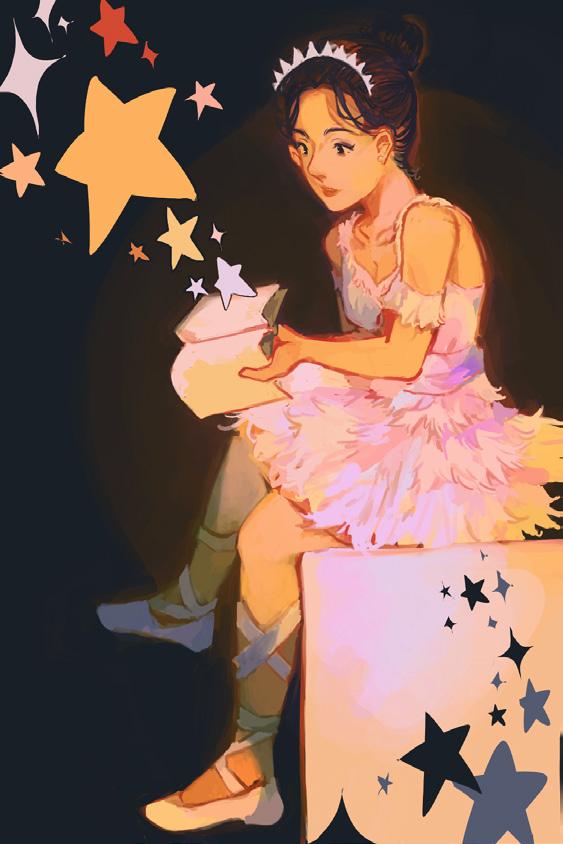
BY MOLLY THOMPSON mmtthompson@ucdavis.edu
Perhaps the greatest value instilled in me from my time at my home studio (shoutout to Dancenter in Santa Cruz) is the value of true commitment, especially to a team. In a piece of choreography, each dancer is vital to the integrity of the performance; commitment is crucial because we all rely on each other. It’s impossible to move forward or productively work on choreography if not everyone is present, so it’s heavily stressed in the dance world that you show up to rehearsal. Always.
Tis notion of “showing up” is true for a majority of team sports, and it’s also true in our society at large. Commitment and reliability are important in the workplace, in friendships and relationships, in hobbies and in higher education. Tose skills pay of beyond the studio, feld or court.
Tat instilled sense of responsibility to a group has made me a very dependable person. I can thank my dance teachers for that.
Bad Bunny initiates a dynamic conversation around the issues affecting Puerto Rico
BY SABRINA FIGUEROA sfigueroaavila@ucdavis.edu
On Jan. 5, Bad Bunny released his sixth studio album, “DeBÍ TiRAR MáS FOToS.” While he sings about love and heartbreak in some songs, the album is ultimately a love letter to Puerto Rico: the land, the people and the culture. Because this is the objective of the album: Tere are some subtle — and some not-so-subtle — social and political commentaries made about the state of the island, considering its current occupation by the United States.
Bad Bunny flls the album with traditional Puerto Rican genres like plena, salsa, bomba and reggaeton, allowing for every generation of the island to be seen and connected with.
Sara Delgado from Teen Vogue said it best in her article.
“‘DeBÍ TiRAR MáS FOToS’ is more than just an idyllic postcard,” the article reads. “It is also an act of activism and cultural reclamation.”
“DeBÍ TiRAR MáS FOToS” shows that music, media, history and the celebration of culture is an act of resistance. T ey are used to educate individuals about occupation, gentrifcation, mass tourism and the ostracization of local people. While all of these themes are present throughout the album, what stands out most was the short flm that Bad Bunny released along with the project.
Titled the same as the album, the short flm depicts an older, well-traveled Puerto Rican man who wishes he had taken more photos of Puerto Rico before it was occupied by the U.S. He goes to a cafe or restaurant and, while he is walking, Americans give him
weird looks — as if he is the one who doesn’t belong there. Te man wants to buy two food items, costing him $30, which he can’t pay for because the café doesn’t take cash. Eventually, a young man pays for the food, reassuring the man that Puerto Ricans are still there and always will be. As much as it is a story of how we should try to capture and cherish good times, it’s also a story of how struggles are generational and how memory serves an important role in fghting those struggles. Memories and the act of remembering — whether it’s about the past, the people, food, culture or specifc moments in time — haunts oppressors. Tis album is especially timely in the context of the current U.S. political climate, given that Latinos are being painted as outcasts. During the height of the 2024 U.S. presidential election, Tony Hinchclife — who, ironically, is an uncomedic comedian — attempted to make a joke that Puerto Rico was a foating piece of garbage.” At the same time, Donald Trump falsely claimed that immigrants from Haiti were eating dogs and cats. And, as you are reading this, ICE raids and mass deportations are occurring in many parts of the U.S., especially in sanctuary states.
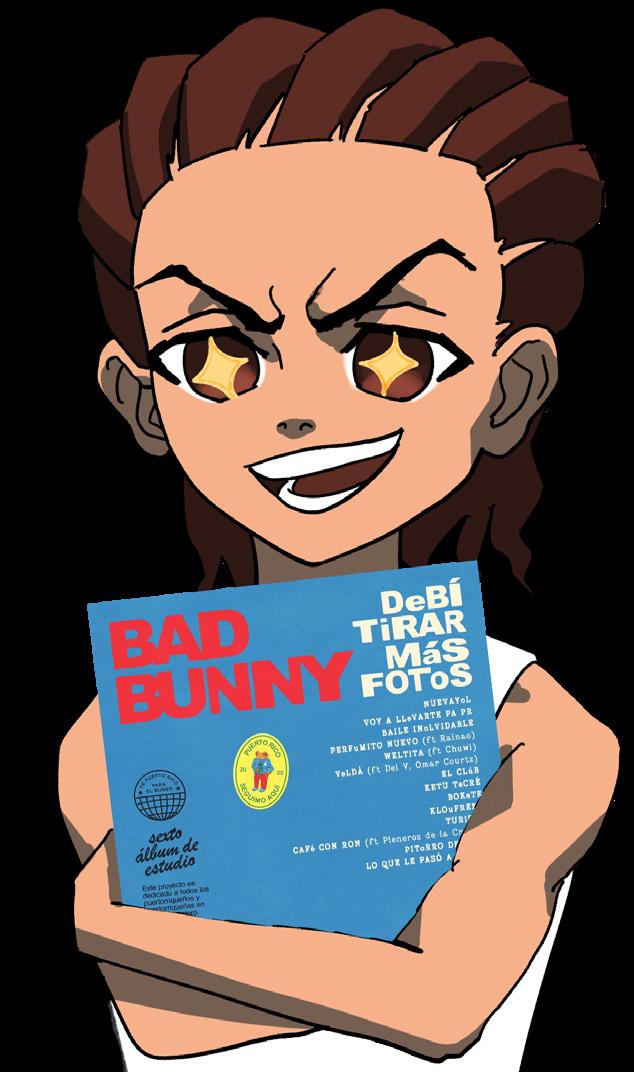
Tough the album’s main focus is Puerto Rico — deservingly so — the commentary transcends borders and language, hitting home for many other Latin American and Caribbean people. Tough these countries all have unique cultures, Latin American and Caribbean countries have been victims of gentrifcation for a long time, so it’s easy to see why so many people have connected with Puerto Rico’s situation.
Fans of the album have shared their appreciation on social media through
a popular TikTok trend, in which they post photos of their lost loved ones, their home countries or even childhood pets to the song “DtMF” — even nonSpanish speakers and non-Latinos have shown admiration for specifc lyrics and songs. Tis album wholeheartedly reminds Latinos to stand their ground and make themselves unforgettable — we are still here and we always will be.
Disclaimer: Te views and opinions expressed by individual columnists belong to the columnists alone and do not necessarily indicate the views and opinions held by Te California Aggie.
Exploring the importance of sports in community building
BY VIOLET ZANZOT vmzanzot@ucdavis.edu
Te Philadelphia Eagles — my team — are the 2025 Super Bowl champions. Of course, when I say “my team” I mean that it is their wins I celebrate and their losses I mourn. I share this team with millions of other people, just like I share the Boston Red Sox, the Auburn Tigers and the UC Davis Aggies.
Saying a team is mine feels synonymous with naming a place, in my case Alabama, as my home. It is mine, but I share it with millions of other people. Tese things do not belong to me alone, but I ascribe them to the communities they embody. Tey are mine because I have memories associated with them and because in some way, they have shaped me into the person I am today.
To love a team is to be part of a collective, to care about something bigger than yourself and to know that, even though everyone may be there for a diferent reason, you all share the purpose of participating in and supporting the community itself.
It’s easy to not understand sports — not just the rules, but the passions behind the fans. From outside the sports world, it may be difcult to grasp why people dedicate Sundays to the couch, glued to the TV for 18 weeks (and also for playofs), or why people buy $150 jerseys or fy across the country to see the team they watched as a kid play. As someone from the inside, it just makes sense.
Te impact a team can make on an individual and a community expands beyond the fnal whistle of a game. Lincoln Financial Field, the Eagles’ stadium (along with the team itself) has dramatically impacted Philadelphia’s economy. Retail vacancy in Philadelphia now sits at 2%, and the increase in foot trafc around game day by both
locals and tourists boosts revenues of surrounding businesses — the expansion only continues.
Teams generate even more sales related to game tickets, concessions, merchandise, sponsorships and advertising, efectively bringing people in to support a town. Outside of fscal impact, they go further with outreach.
Teams support charitable endeavors: Look to the Eagles’ Autism Foundation or the Eagles’ Charitable Foundation.
Beyond that, teams increase social capital, a measure of the quality of life.
Sports build interpersonal relationships, social networks, civic engagement, trust and cooperative norms.
Sports, of course, can mean a lot of diferent things, whether one is referencing pee wee soccer, Major League Baseball, women’s rugby, the National Hockey League or anything in between tag and synchronized swimming.
Thank you to my dance teachers HUMOR The beef between
It’s no secret that our childhood experiences shape who we become as adults. Te way we were raised, where we grew up, the friends we had, our elementary education and so many other factors cumulate to create who we are now. Perhaps one of the most infuential elements of this equation is the extracurricular activities we were most heavily involved in. Especially in middle school and high school, it’s hard not to equate personal identity with after-school activities (at least to a certain extent). You’re a football player, a theater kid, a tennis star, a horse girl, a mock trial nerd, a volleyball athlete, a roller skater or a dancer. Tat was me: I’m the dancer.
My mom put me in ballet classes as soon as she possibly could — which ended up being when I was three. So, as long as I’ve known myself, I’ve understood myself to be a dancer. It’s safe to say that dance had a massive infuence on who I grew up to be. I studied ballet the most, but I also practiced jazz, contemporary, modern, Latin and hip-hop. By my fourth year of high school, I was in the studio for 20 to 25 hours a week.
We dedicate so much time and energy to organized sports, so it’s only natural that they have a heavy hand in crafting our characters.
With any demanding extracurricular, you need elite time management skills. On any given Wednesday, I was at school from 8 a.m. to 2 p.m. (or something like that). Ten, I did a little Advanced Placement (AP) Calculus homework at home before going to the dance studio at 3:45 p.m., remaining in dance classes until 9 p.m.; Ten, I’d drive myself home and make a quesadilla or a bowl of pasta (my parents had eaten like three hours earlier), and fnally I’d fnish up my AP Government assignments, shower and fall into bed. On top of other extracurriculars like mock trial and working on the weekends, I genuinely can’t fathom how I stuck to that schedule daily. But this schedule gave me some serious time management skills, and most people who were involved in sports and any number of other activities can say the same. Balancing all of those commitments requires meticulous planning and efficiency, which is still how I operate (okay maybe not always, but at least I know that I can). Collegiate schedules can be similarly demanding — those skills have to come from somewhere.
Growing up in dance studios has also manufactured the way I respond to critiques.
The type of sport and level of play have their own impacts and implications, but all sports can build community — it’s just a matter of the impact size and involvement between those on the “feld” and those cheering
on the sidelines.
Being a fan makes an individual part of a community. Whether you’re in Argentina, Australia or America, you can cheer for the Eagles — and you will have people cheering with you. You may have people cheering against you, too, but those people are wrong, so don’t listen to them (just kidding). Regardless of who you cheer for, the point is that the simple act of cheering for someone gives you a place to belong.
Sports build more than an economy and do more work than what you see on magazine covers — they give people something to connect with as they pass each other on the streets (for instance, exchanging a “Go birds!”). Being a supporter of a team, a fan, gives you something to cheer for or cry about, something to drink, eat and scream about; And, most importantly, it gives you people to do those things with.
Disclaimer: Te views and opinions expressed by individual columnists belong to the columnists alone and do not necessarily indicate the views and opinions held by Te California Aggie.
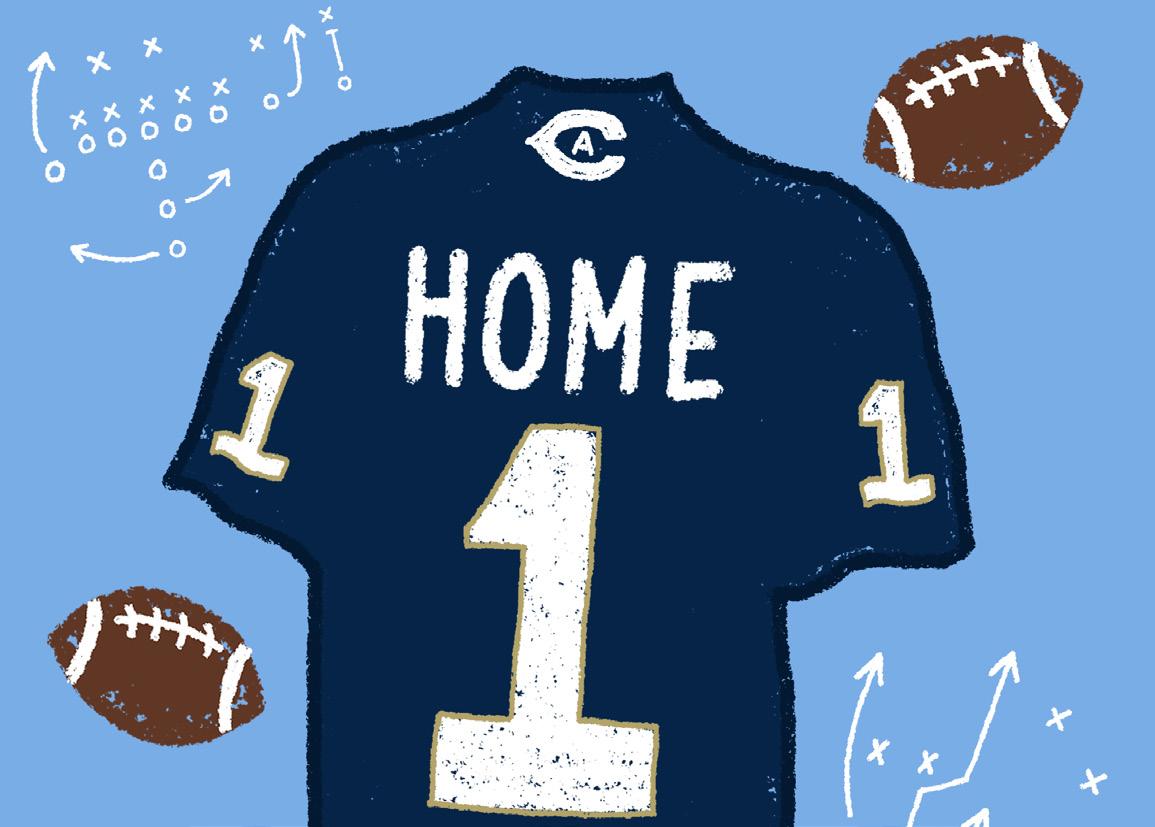
Where weather meets waddle
BY NEVAEH KARRAKER nakarraker@ucdavis.edu
Skepticism takes hold of us all. It roots itself deep within our core, refusing to grant leeway and proliferating into irrational loathing. But perhaps it’s not truly skepticism — instead, perhaps fear? Fear that, despite
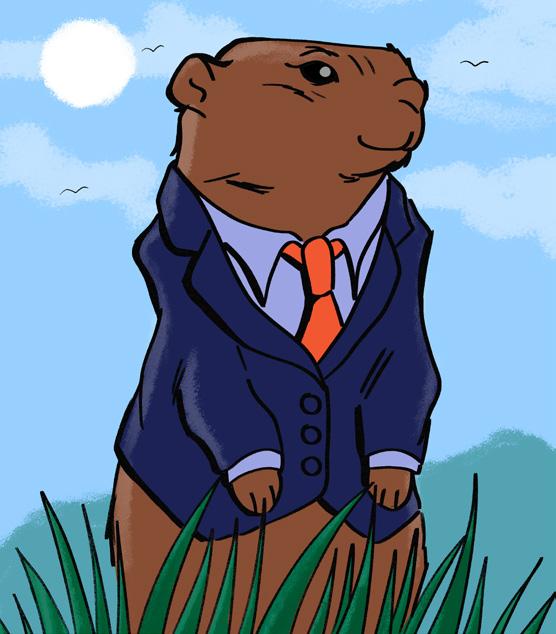
all of our meticulous calculations and tireless labor, something as small as a rodent can strip us of reason: the fear that people will continue to choose folklore over data. For 139 consecutive years, meteorologists have been experiencing an unspoken “cold war” with groundhogs. It’s a battle of satellites versus shadows, science versus superstition. Through decades of research, advancing technology and complex algorithms, we have analyzed the Earth’s atmosphere and tracked climate patterns. And yet, it bafes me how a chubby creature, with one theatrical display, possesses the power to sway public opinion. You might as well dress up the little guy in a mini tuxedo, give him a mic and place him in front of a green screen. People would probably take the weather we slave away studying more seriously if a semi-cute (I guess) animal was delivering the forecast on television. Or maybe that’s my pride speaking.
Was he hiding some revelatory knowledge within his burrow and mixed among his twigs? As an individual of science and logic, I scof at the thought. And yet, standing on the frozen ground, with nothing distinguishing me from the thousands bundled in wool coats and scarfs, I couldn’t shake the smallest whisper of curiosity.
“Phil, Phil, Phil.” Te frst round of chants.
“Phil, Phil, Phil.” A man wearing a top hat strides forward, polished shoes crunching on the frostbitten grass. In his leather-gloved hands, something extremely fufy squirms. Dramatically, the man hoists Punxsutawney Phil above his head for all to see. His tiny paws extend toward the heavens, demanding the crowd fall into an anxious silence. Phil whistles, capturing the crowd’s attention. Ten, ever so slightly, a shadow begins to grow underneath him.
Negotiations must be fair and inclusive to prevent further
WRITTEN BY THE EDITORIAL BOARD
Feb. 24, 2022 marked Russia’s launch of a full-scale invasion in Ukraine, which sparked the largest and deadliest confict in Europe since the end of World War ll. Now, three years down the line, a collective 500,000 troops have been killed or injured on both sides, and peace negotiations between the two countries — along with the North Atlantic Treaty Organization (NATO) and the United States — have proven unsuccessful.
However, a lot has changed in the years since the start of the confict. Ukraine, in order to protect its freedom from Russian oppression, was forced to strategize and innovate. With limited military resources, President Volodymyr Zelenskyy appealed for foreign aid. He rallied in-state troops, and technological developments fourished.
Some of these advancements include satellite-based technology for documenting war crimes and tracking Russia’s military advances, facial recognition technologies to
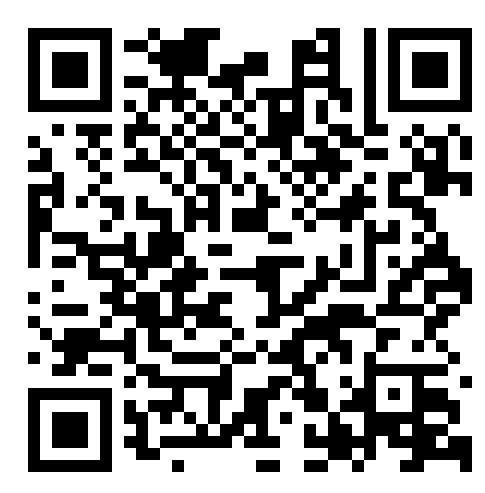
identify missing persons as well as breakthrough drone technology to target mid-air missiles. Forced to make do with very little, Ukraine’s military has evolved substantially, developing their arms for modern warfare.
Even so, Ukraine has lost territory since the beginning of the war; As of Feb. 12 this year, Russian forces are occupying a signifcant portion of land at the border, including major cities Donetsk and Mariupol. In addition, Ukraine recently lost foreign aid from the U.S.: a motion led by the new Trump Administration. Te current state of the war is a stalemate — one that continues to result in casualties on both sides.
Now, it seems as though America is turning a blind eye toward Ukraine.
President Donald Trump recently engaged in a “lengthy and highly productive” phone call with Russia’s president, Vladimir Putin, in which the leaders agreed to begin negotiations to end the war in Ukraine, according to BBC. Tis was done without Ukrainian involvement — or other European leaders for that matter — sparking global unease and outrage.
Notably, this surprise call follows shortly after Trump demanded 500 billion dollars worth of rare-earth minerals from Ukraine, as the price for the United State’s continued military support. In a country already ravaged by war and a nearly exhausted supply of resources, this request is a clear sign that Trump is not as sympathetic to Ukraine’s war eforts as former President Joe Biden was.
In fact, during his frst term as president, Trump was notoriously friendly with Putin, praising him for doing “an amazing job of taking the mantle” and annexing Crimea in 2014 (a Ukrainian territory), spreading Russian disinformation and propaganda about the war in Ukraine in 2019-2020 and inviting
Putin to the 2020 U.S.-based Group of Seven (G7) summit despite outrage from all involved. It is clear that their relationship is complex yet agreeable and a sign that the Ukrainian people are in even more desperate need for the world to care — to see Russian atrocities and Trump’s afnity for Putin for what they are.
Now, as Russian and U.S. representatives head to Saudi Arabia for peace talks, European leaders — headed by France’s president, Emmanuel Macron — are doing the same in Paris. Ukraine, notably, was not invited to participate in either conversation. World leaders are trying desperately to remedy Trump’s hasty approach to negotiations, while missing one crucial step: giving Ukraine a seat at the table.
Now is the time for equitable conversations to ensure future peace, which must include everyone involved, in order to bring an end to this deadly confict. A solution where Ukrainian ofcials are not included is not a solution at all but a dangerous gamble that gives Russia time to regroup their forces in order to strike again. Because, as senseless as this war is, it has proven to the world the lengths to which Putin will go to get what he wants: the end of a sovereign country and an extension of his power and infuence into Europe.
War, especially a prolonged one, results in both physical and psychological fatigue, along with an exhaustion of resources. Despite fading from mainstream U.S. media, Ukrainian citizens continue to be killed and displaced by missiles, their nights flled with the echoes of sirens, existing with a fractured sense of self amidst unrelenting Russian aggression.
We need to continue supporting a Ukrainian victory. Te alternative — an erasure of an entire country and culture, along with an extension
It’s rough out here
BY ALLISON KELEHER adkeleher@ucdavis.edu
Te other day, I was taking a stroll through the Memorial Union (MU) Quad when I looked to my right and saw Gunrock lying face down in the grass. His shoulders were shuddering and there appeared to be a pool of tears collecting beneath him. I can’t lie, we have all been there, so I paused to go comfort our beloved horse.
“Gunrock, what’s wrong?” I asked as I rubbed his back to soothe the tears.
Tis resulted in a loud sigh and further sobbing from Gunrock. When he fnally fipped over, I winced because his muzzle was all squished from lying face down on the ground. He snifed a couple of times before I gave him a tissue to blow his nose. With a loud
“HONK,” he blew his nose and then went to compost the tissue (since we are a sustainable campus).
When Gunrock returned, he sat down on the grass and began to spill the tea.
“She was amazing,” Gunrock said. Te most amazing horse I have ever met, and I was willing to give her anything she wanted. She is so kind — one time she stopped to give someone a ride to class when they missed the bus. And, she would never ask for anything in return.”
“Aww Gunrock, that’s so sweet,” I said, to support his healing process.
“But that’s not all, she had the most stunning body—” I cut off Gunrock right there, because I’m not trying to hear all that. Tis resulted in a loud groan from Gunrock, since he was annoyed with my prude nature.
“All I’m saying is that her coat was beautiful,” Gunrock said. “She was a sleek brown stallion and the subject of all of my deepest desires.”
“Well, what happened, Gunrock?”
I asked.
I regretted asking this question, because his eyes immediately welled up with tears and he slumped over onto my shoulder. I had to pat his back for a solid half an hour until he could compose himself.
To spare you the details, Gunrock eventually told me that she dumped
him after their Valentine’s Day date. I felt bad until he proudly stated that they went to Raising Cane’s, since it’s ‘red inside’ and ‘an ofcial sponsor of UC Davis Athletics.’” Unfortunately, our mascot is not very romantic. His stallion showed up wearing her best horseshoes with the red bottoms, according to my sources. Her face reportedly appeared disgruntled throughout their entire date. Afterward, she sprinted away from Gunrock, tail billowing in the wind. Gunrock was left standing outside of Cane’s, with her rejected rose bouquet in his hands. After all of that, Gunrock couldn’t muster anything besides laying on the ground and crying. Apparently, UC Davis Athletics is getting upset with him, because he keeps cancelling all of his appearances. However, Gunrock doesn’t care if they fre him, because he is entirely consumed by thoughts of his ex.
“Now, I’m so blue,” Gunrock said
through the tears. It was at this moment when I heard rustling in the distance, and a large horse came galloping toward our spot on the MU Quad. It was her. Gunrock was right — she is beautiful, and she is also several feet taller than him.
He looked up with stars in his eyes and began to apologize.
“I didn’t know where to take you for Valentine’s Day,” Gunrock said. “I’ve never had a lady friend before.”
She seemed to like this response, because they immediately began to make out right in front of me. Tat’s when I left them alone. In the end, I don’t have much more to report other than the fact that our mascot has no game.
Disclaimer: (Tis article is humor and/or satire, and its content is purely fctional. Te story and the names of “sources” are fctionalized.)
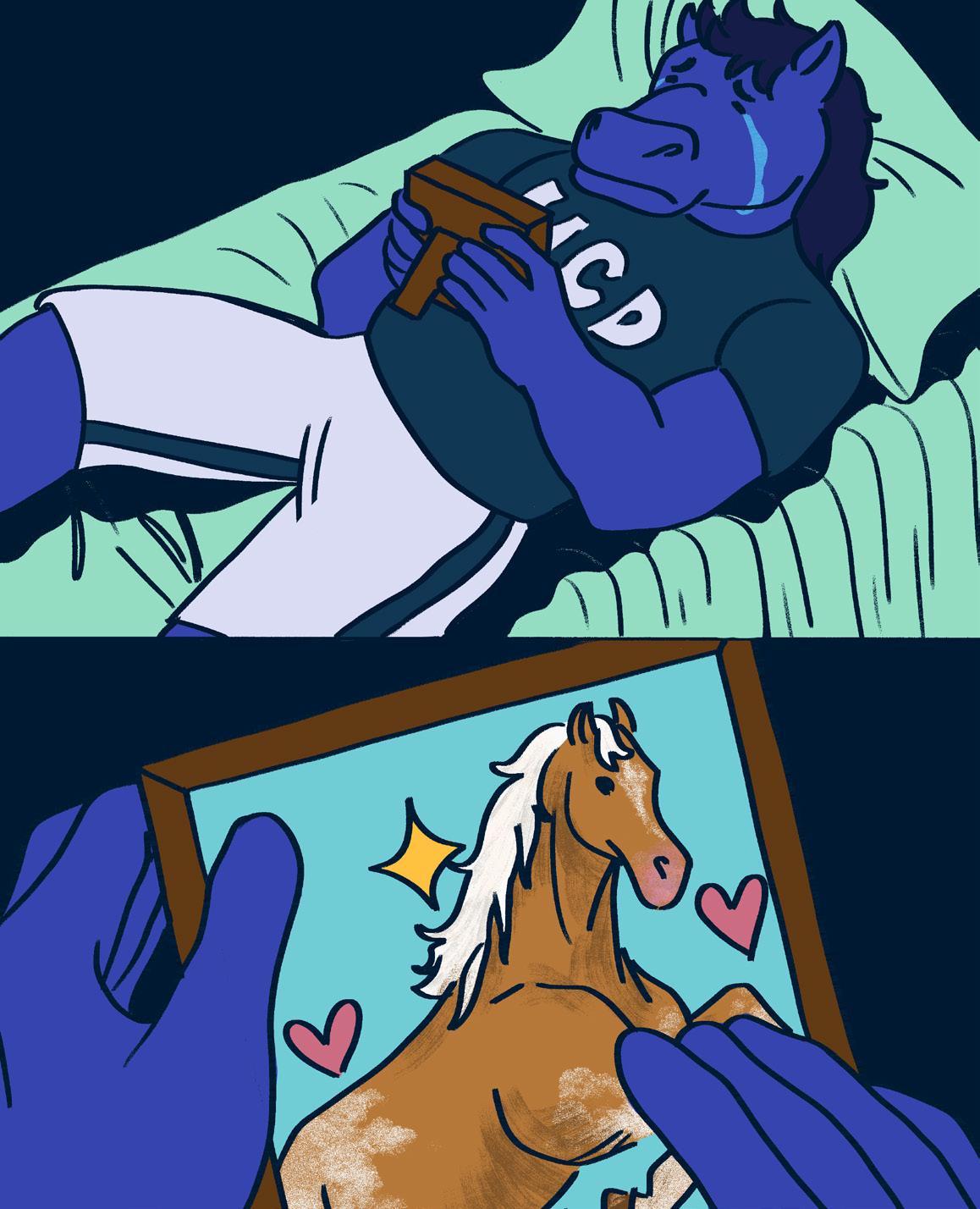
Editorial Board
CHRIS PONCE Editor-in-Chief
ALYSSA CREVOISERAT Managing Editor
MADISON PETERS Campus News Editor
HANNAH SCHRADER City News Editor
MAYA KORNYEYEVA Opinion Editor
ZOEY MORTAZAVI Features Editor
ANA BACH Arts & Culture Editor
MEGAN JOSEPH Sports Editor
KATIE HELLMAN Science Editor
JENNA LEE Photo Director
ARIANA NOBLE Layout Director
LANHUI ZHEN Design Director
JOANNE SUN Social Media Manager
AARON POTTER Website Manager
CASSIDY GILLIS Distribution & Outreach Director
TIFFANY HE Copy Chief
JENNY DYE Copy Chief
SAMUEL RUIZ Translation Director
ILEANA MERAZ Translation Director
LAURIE PEDERSON Business Development Manager
of Russia’s authoritarian regime — is unimaginable. While it is true that we should prioritize the well-being of our own country and resources, we cannot snub or ignore a global confict that peters on the brink of afecting the
global geo-political balance of our modern world. Russia’s aggression against Ukraine is a war against democracy and a bold challenge to global leaders declaring what Putin is ready and willing to do.
Is that product really as sustainable as it claims to be?
The looming rise of greenwashing and how to recognize it
BY ELLIE NOH eenoh@ucdavis.edu
Many individuals, especially in companies, recognize the detrimental impacts of climate change caused by human activities. While some organizations have corporate goals to improve sustainability in production and distribution, others might not truly be using environmentally friendly practices — or may be harming the environment through other means. Tis corporate facade of sustainability, which is used to mislead the public about a company’s true environmental impact, is known as “greenwashing.”
Because of consumerism, the impact of waste has grown more dire and the use of green advertising has not been efective in mitigating such practices. One such case is fast fashion, which has one of the worst environmental impacts to date. 10% of carbon dioxide emissions worldwide are due to the fast fashion industry, according to the Center for Biological Diversity. If fast fashion continues to rise, greenwashing slogans and messages platformed by certain companies may cause consumers to believe that they are contributing to sustainable fashion when they are not.
To further this idea, in recent years, there has been a growing awareness for sustainability, with more individuals trying to implement environmentally conscious day-to-day actions — especially those popularized on social media. Environmental advertising is a tool that often gives companies an advantage since more people might be inclined to purchase products that seem to be eco-friendly.
While some forms of greenwashing are more obvious than others, companies use many subtle tactics to make their products seem more environmentally friendly.
This includes using ambiguous words such as “eco-friendly” — which is a term subject to various interpretations — thereby influencing consumers to believe they
are contributing to a greener future.
Another common method is to utilize images that contain aspects of nature, like plants or animals, in order to give the impression that the overall theme of the brand is focused on conserving nature.
However, while it is important to be critical of advertising messages, it is also important to note that, while some companies may be using these greenwashing strategies to increase consumer purchases, it doesn’t mean that other companies use similar ideas to reliably market their products. Tus, there exists an individual need on the side of the consumers to do their own research and buy products that are actually sustainable. Companies regularly release sustainability reports which people can freely peruse to analyze the environmental impacts and identify a company’s true goals.
Additionally, some organizations aim to help with this ongoing issue of greenwashing. For example, the Federal Trade Commission’s Green Guides are established sources that provide assistance with marketing truthfully, encouraging companies to ensure that their products are as sustainable as they sound.
As the fght to decrease the human impact on climate change continues onward, it is essential to have these truthful measures to help implement environmental change. Given that these changes can take time, it is fundamental that we do our own research and recognize which companies are being truthful and which are not. While many organizations are working toward clear-cut, reliable marketing, existing greenwashing tactics and the widespread nature of consumerism necessitate that consumers think twice before purchasing a potentially “green” item — it may not truly be as sustainable as it seems.
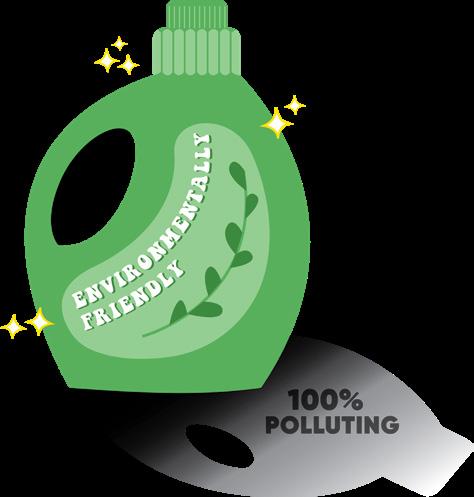
Disclaimer: The views and opinions
Thoughtful ways to make Ramadan more meaningful for everyone
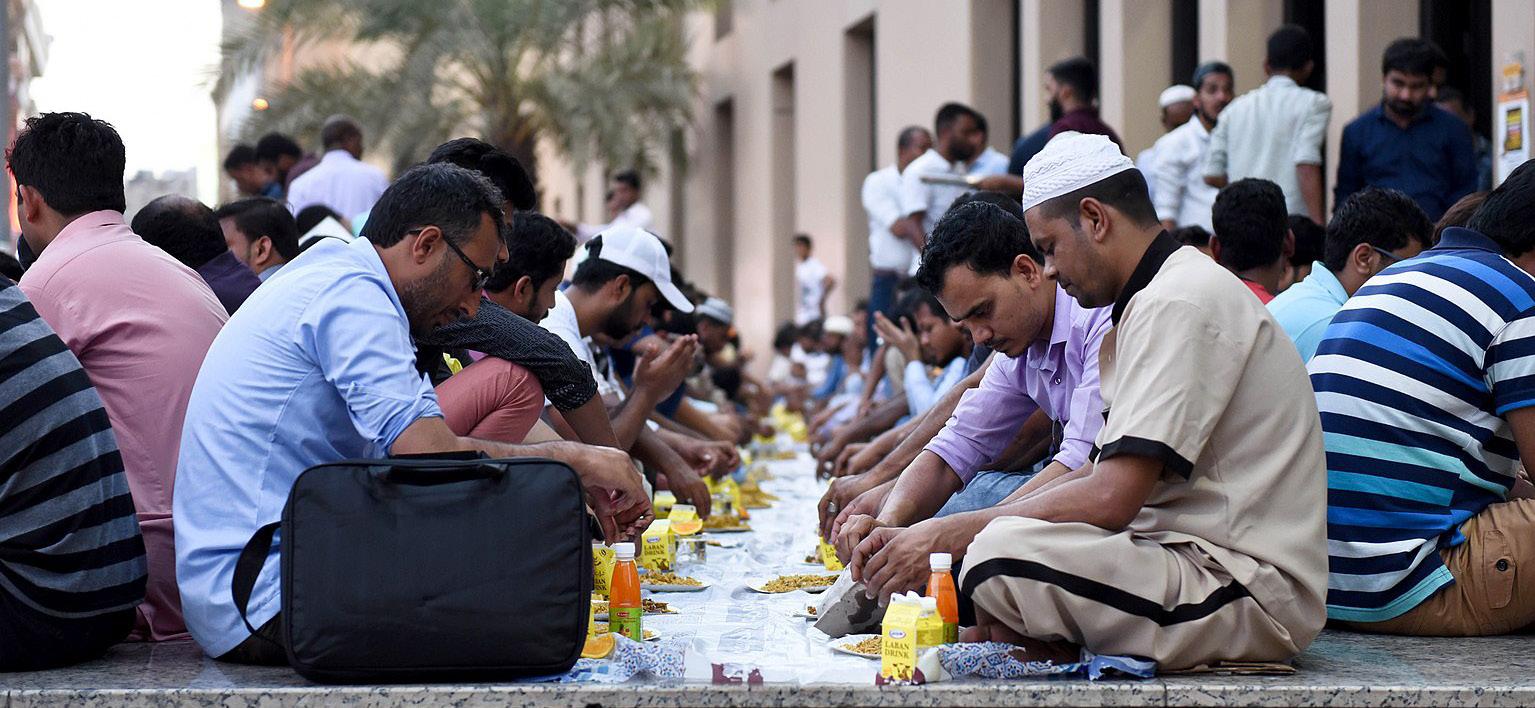
BY IQRA AHMAD arts@theaggie.org
Te month of Ramadan is approaching fast, as it begins next week, from Feb. 28 to Mar. 29. Tis month in the Islamic calendar marks a sacred time that is observed by Muslims around the world. It is a period of refection, gratitude and community, in eforts to encourage better habits of patience and generosity.
Commons, CC by 2.0) and upbringing. Many families have unique traditions, including special dishes prepared for Iftar (breaking of fast). Some might have childhood memories of staying up late for Suhoor (the pre-dawn meal) or gathering with loved ones for Taraweeh (night prayers at the mosque). Others might share how fasting has shaped their personal growth and strengthened their sense of gratitude. Asking questions can be a wonderful opportunity for you to engage with your friends and learn what Ramadan means to them.
If you have friends observing Ramadan, ofering thoughtful gifts or simply taking the time to learn more about the signifcance of this month can show your support and make them feel truly appreciated. Here are ways that you can participate:
Learn about Ramadan:
Acknowledging the values and practices of Ramadan can help you understand its importance. During this month, Muslims fast from dawn until sunset, refraining from food and drinks as an act of devotion and self-discipline. But Ramadan is much more than fasting — it is a time for spiritual refection, increased prayer and acts of kindness. Giving to charity, known as Zakat, is an essential part of the month, reinforcing the values of generosity and compassion.
You can also ask your friends about their experiences and traditions. Ramadan is observed diferently depending on one’s culture, region
Join in Iftar gatherings: By joining your friends for Iftar, the meal that breaks the fast at sunset, you can be part of the camaraderie and spirit of Ramadan. Many families prepare special dishes for this occasion. Being part of an Iftar gathering, whether at home or in a local mosque, can be a heartwarming experience. If you’re invited, bringing a small contribution — dates, a traditional food or a dessert — can be a thoughtful indication that you care.
Gifts or crafts: If you enjoy creative projects, making do-it-yourself (DIY) Ramadan crafts can be a fun experience to celebrate. A handmade Ramadan card with a message can brighten your friend’s day. You can also create decorative lanterns inspired by the traditional Fanous, which are commonly used during the month,
or put together a countdown calendar to mark the days leading up to Eid alFitr.
Toughtful gifts can make a world of diference in showing your appreciation for your friends observing Ramadan. A box of dates and snacks makes for a perfect and practical gift, while scented candles or essential oils can help create a relaxing atmosphere after long fasting hours. Books or journals also make wonderful presents, providing space for contemplation and refection throughout the month.
Celebrate Eid with them:
As Ramadan comes to an end, it is followed by Eid al-Fitr, a joyous celebration marking the conclusion of fasting. If your friends invite you to join in their Eid festivities, it is an amazing opportunity to celebrate together. Bringing a small gift, sharing in traditional foods and simply being present in their happiness can make the day even more special for them. Your kindness and willingness to understand their experience will not go unnoticed, and your friendship will be all the stronger for it.
As Ramadan approaches, these thoughtful suggestions provide meaningful ways to support and celebrate with those observing it. By taking the time to understand and engage in Ramadan, you can make this month even more special for those around you.
I deleted Instagram, and the world didn’t end
BY NATALIE SALTER arts@theaggie.org
As I’m sure many others would agree, social media has often felt like a necessary evil. It’s what you exchange with new acquaintances after that alltoo-familiar college student small talk, when “What’s your major?” turns to “What’s your Instagram?” It’s how you stay in touch with that high-school friend you don’t quite know anymore or that girl you met once at frst-year orientation. It is, essentially, a simple and useful means of maintaining those relationships that linger in the not-quite-friends, not-quite-strangers limbo. And, of course, it can be a lovely little window into the everyday lives of dear friends and family.
If only it were as simple as that, because social media is a beast as well. It drowns you in the worst of global news and imbues you with insecurities you didn’t know existed. Consumerism costumes itself in words like “productivity” and “confdence,” telling you that emptying your
wallet is the only path to personal satisfaction. Trends fall in and out of style and relevance at breakneck speeds, and judgment is social media’s primary language.
For years, I’ve weighed whether abandoning Instagram would be possible. Te short answer is no: it is far too necessary for a social utility to drop entirely, and for all its evils, it does have its benefts (few as they may be). However, deleting the app from my home screen while keeping my account up was an option. I could check it only when strictly necessary, such as to reply to a message from an acquaintance, and otherwise lock it away and forget its existence. I debated this for a long while until the frst day of February rolled around and I, in a burst of willpower and inspiration, decided to at last carry out my plan.
Instagram disappeared from my screen, and my relief was instant, though my adaptation was slow. Every time I habitually tapped at the spot on my phone screen where Instagram once was — only to fnd nothing there
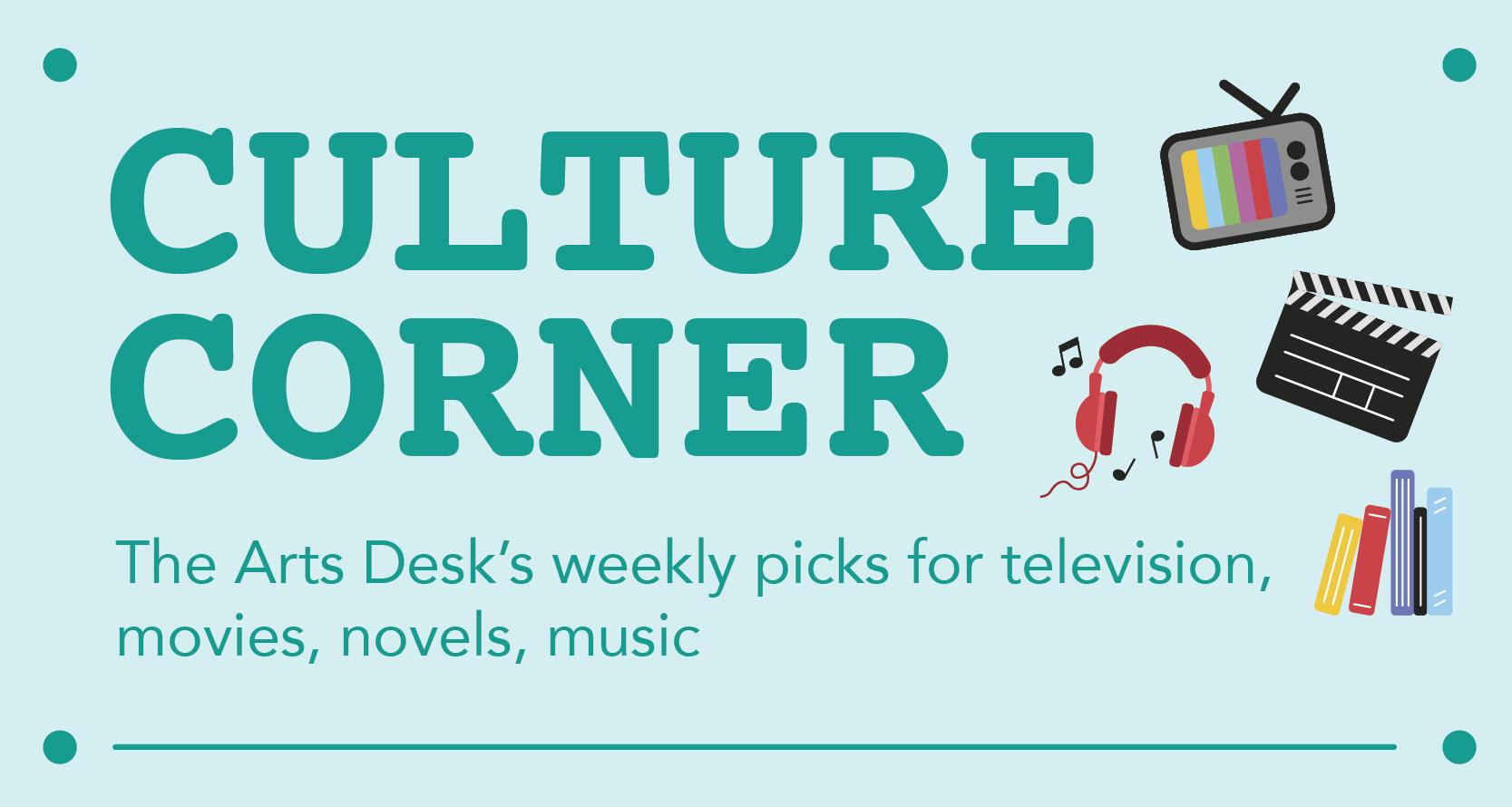
BY JULIE HUANG arts@theaggie.org
Movie: “Cinderella” dir. Kenneth Branagh (2015)


Although I maintain that animations retain a magical quality that live-actions flms usually fail to replicate, an exception is made for 2015 rendition of “Cinderella” — the live-action remake adds more intricate visuals and brings depth to certain characters. For one, the narrative choice to frame the evil stepmother as a foil to Ella herself adds an enjoyable sense of tension and tragedy. However, the costuming may be the most enchanting facet of the flm. Te animated Cinderella’s iconic silver ball gown is adapted into a breathtaking blue variant that shines brighter than every other dress at the ball. Tis is a deliberate choice that highlights Ella’s one-of-a-kind innocence and kindness that shines from within. Tanks to the costume designers’ attention to detail, though, the external presentation is just as radiant.
Song: “Wuthering Heights” by Kate Bush (1978)
During the rainy season, indulging in periodic glances out of the window to watch puddles grow ever larger on the uneven pavement outside is a classic activity enhanced by background music — and “Wuthering Heights” is particularly appropriate. As a retelling of Emily Brontë’s only novel, Kate Bush’s shivering vocals and enigmatic lyrics perfectly represent the Gothic novel’s toxic relationships, its perpetually windy, stormy English moors and my mood while studying for midterms. I also admire how the song manages to ft a remarkable amount of content into four minutes and 29 seconds, given that the novel it’s based on is usually around four hundred pages long.
TV Show: “Gossip Girl” (2007 to 2012)

— it was like a rubber band snapping on my wrist. It made me realize how frighteningly tied to the app I had been and quickly turned my attention to what I could entertain myself with instead.
I turned to my long to-be-read pile, ever-growing on my already-crammed bookshelf, and found myself reading over morning cofee and late-night mugs of tea. I reached out more than ever to loved ones, showering them with expressions of gratitude for their presence as I realized how integral they were to my life. I even studied more enthusiastically than before, taking extra notes on supplementary readings simply because I had the time to.
Everything seemed to be going well. My mood steadily improved, and engaging my mind more productively in my free time gave me a level of energy and vigor I had no idea I was capable of. With fewer opportunities to compare my internal and external life to others, I found my self-worth somewhat bolstered. Each passing day imbued me with more confdence in

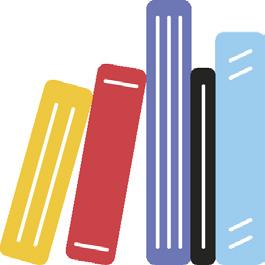
On the one hand, it’s a teen drama of the 2010s that has already had its time to shine, but on another hand, it’s perfect if one ever feels like watching self-important rich people engage in psychological warfare with one another, competing to see who is the most out of touch. Te plot largely consists of every major character on the show taking turns backstabbing or dating each other, or both, but it makes sense within the context of the show, kind of. An advantage of the characters’ massive wealth is their easy access to expensive fashion, which translates on the screen into beautiful costuming completed by eye-catching designer pieces. Overall, “Gossip Girl” remains a good watch if you want to disconnect from reality for a little while and think only about which self-absorbed man the millionaire heiress should end up with.
Book: “Te Seven Husbands of Evelyn Hugo” by Taylor Jenkins Reid (2017)
Overcoming the midst of the quarter usually demands that any leisure reading be low-efort, and “Te Seven Husbands of Evelyn Hugo” is just that — it’s easy to follow but rich in emotional rewards (or devastation). Te novel follows a movie star’s tumultuous romantic history over 30 years through the end of the Golden Age of Hollywood, culminating in her fnally sharing her personal truth in its entirety with a struggling writer who could use the inspiration. Reid’s novel goes from intriguing to gripping to ultimately heart-wrenching, and I was left refecting on its numerous plot twists long after I put the book down.
my decision. Ten one morning, my friend and I stopped at the Cofee House between lectures, and she asked me if I’d heard that one of our favorite artists was going on tour near Sacramento. Tis was news to me. When she invited me to go with her, I accepted happily, but with a newfound sense of disorientation. Just a few weeks ago, I would have known this before she’d even asked. I might have even ofered frst. But now, having severed my link to the well of news that Instagram once was in my life — I was completely and utterly out of the loop. Instagram, and the internet in general, is a complicated thing. We can acquire a great deal of information through social media, but with its delights come steep risks. Trough these platforms, we have little or no way of culling the information that comes our way, so we only internalize what is important or uplifting. An algorithm can only go so far and is not so easily wrangled as the infuencers on your TikTok For You Page might have you believe.
Tus, it became clear to me that I had made a trade-of, for better or worse. By cutting myself of from the food of content that imbued me with anxiety and uncertainty, I had lost access to the snippets of intel that might have pleased me as well. Should my favorite actors post a picture together or should a new song be announced by a favorite singer, I would receive that information late or not at all. Should a dinner conversation with friends turn to the latest shreds of celebrity gossip, I would only be able to listen and play catch-up without sharing my opinion
in the debate. But would any of that be worth it? It occurred to me that in 20 years, it wouldn’t matter whether I had an opinion on this new album or that shocking celebrity couple. And if I did happen to formulate a stance on such issues, my source of knowledge would be shifted from distant strangers to my close friends and family.
We are told that the internet allows us connectivity beyond that which we have ever had access to before, but it struck me that those connections were more often than not tenuous and fragile, lacking in fulfllment and substance. Letting these threads slip through my fngers allowed me to strengthen my grip on the relationships I had in real life. Te opinions of faceless commenters and carefully made-up infuencers on social media would not bring me comfort years in the future — I wouldn’t even remember their names or their words. I could hear or read their thoughts, but there was no equality of engagement, no care and respect shared between myself and them. All we are left with in the wake of these brief online engagements is a feeling — more often than not, a negative one. Tat, I realized, was a trade-of I could accept. If the abandonment of social media forced me to rely upon my loved ones for emotional fulfllment more than ever, then it was for the better. In an increasingly online century, authentic joy is not to be found at the bottom of a neverending feed but in the people we care for in real life and the bonds we share.
The market hosted a craft-filled event in celebration of Cupid’s holiday
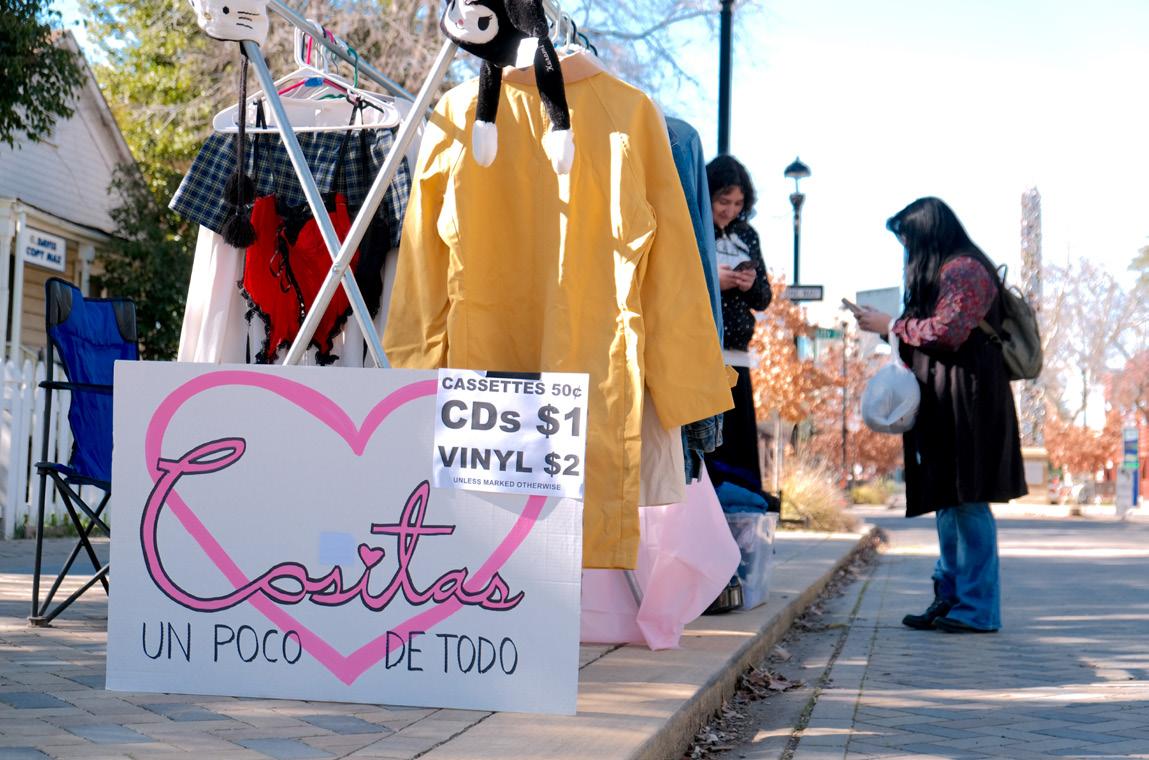
BY DEVANSHI AGNIHOTRI arts@theaggie.org
Precious crochet animals smile at you and beads sparkle as you make your way down 3rd and B Street. Te Davis Street Market’s Valentine’s Day Show was held on Feb. 8, with the street flled with vendors selling an assortment of handmade products and some having Valentine’s Day-themed items.
Te Davis Street Market has been a place for people to slow down their walk to the Davis Farmers Market or through downtown, and the vendors have worked to maintain the market as a community for everyone.
Rachel Jenson, the owner of Vivid Customz and a moderator of the Davis Street Market, has strings of beads up to nine-feet long on display. She has been a vendor for a little over three years and previously sold paintings but now sells waist beads, anklets, bracelets and stickers.
For Jenson and many vendors, the items they sell trace back to their own shopping experience and their desire to give shoppers an authentic as well as ethical product.
“I was selling because I wanted others to feel how my beads made me feel,” Jenson said. “I have always had a tough relationship with my body, then I started wearing waist beads and anklets, and I learned to love myself. Now, people tell me they feel that way too. I also try to keep a very inviting vibe at my booth. My beads are for anybody — anybody.”
Jenson emphasized the importance of creating a comfortable experience for customers, which, as the show is open to the public, adds to the event’s welcoming setting.
Te Davis Street Market has grown in popularity through the years, with the number of vendors increasing to roughly 60 in the spring, according to Jenson.
“I have watched many students come and go through the years, and it’s awesome to see the community growing to now 50 to 60 vendors in the springtime,” Jenson said.
Another vendor, Trinh Giang, is owner of @whatstrinhmaking and creates clay magnets, pins and trinkets.
Giang has been a vendor for about two years but started selling handmade items about two months ago.
Despite multiple vendors not selling specifc Valentine’s Day-themed items, supportive energy and love was still in the air.
“It makes me extremely happy to know that my supporters can see my creations and think of specifc people in their lives that would appreciate both the product itself and the sentiment of thinking of those you love,” Giang said.
Te market has become such an integral part of the community, as well as a creative outlet. Giang mentioned not having many creative outlets growing up but said the Davis Street Market has brought out their creativity after they initially began their artwork.
“I decided to sell my craft, because I knew Davis was full of people similar to me who love to spend money on a silly, little trinket,” Giang said. “I was inspired to join the market because of how accessible it was. It is truly the perfect opportunity for beginning artists since the space is free and most vendors are in similar positions of sharing their craft amongst the busyness of their fulltime jobs or education.”
And just like that… ‘Sex and the City’
UC Davis students discuss the show’s resurgence and reintroduction of a new generation to female friendships, aging and sex (obviously)
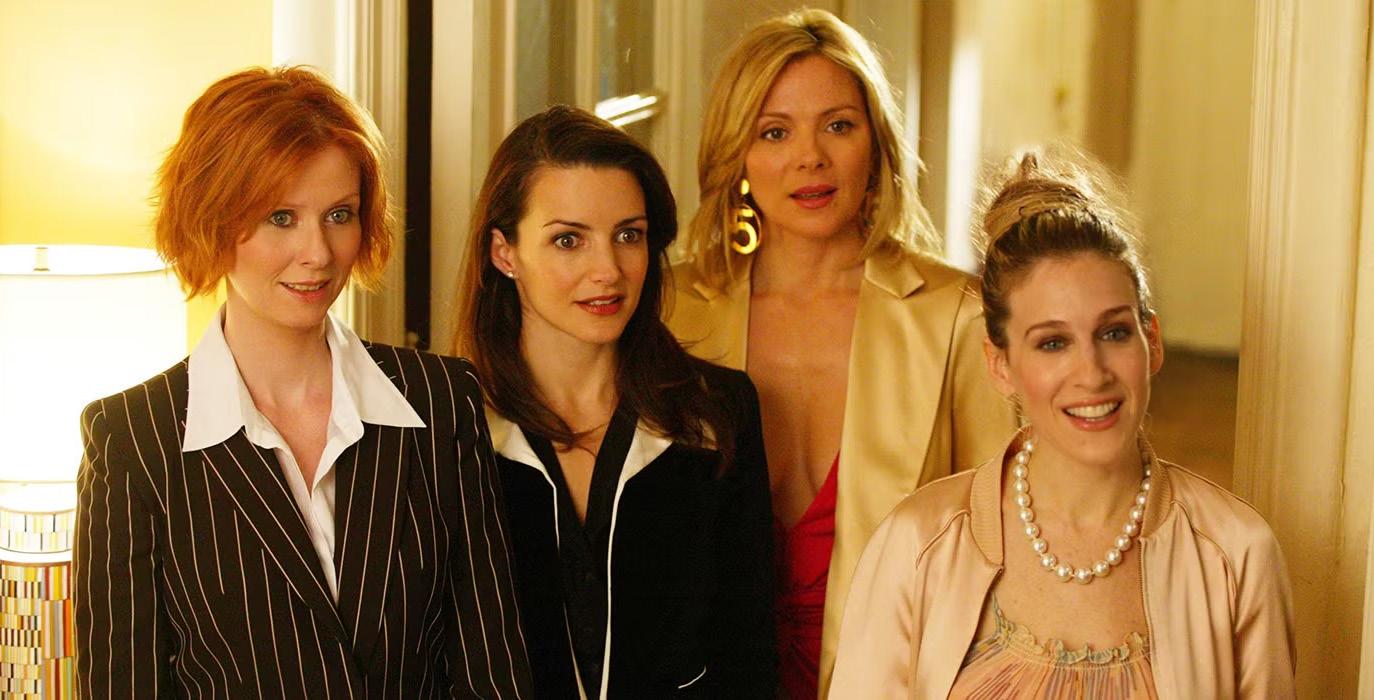
BY AALIYAH ESPAÑOL-RIVAS arts@theaggie.org
“Sex and the City” follows the life of Carrie Bradshaw, a 30-somethingyear-old sex columnist living in New York City. Amidst spilling her sexual relationships every week, trying the hottest restaurants and clubs in NYC and attempting to fnd a place in the ever-changing dating landscape, the show goes beyond just showing the glamorized NYC lifestyle. Accompanied by her three friends, Charlotte, Miranda and Samantha, each episode navigates Carrie’s life, intertwined with subplots of her friends as they all try to fnd what they want most in life: love.
Initially airing in 1998, the show was based on the real-life newspaper column of the same name, written by Candace Bushnell. Produced by HBO, the show went on to have six seasons, two movies, a prequel series and now a revival series that began airing in 2021. Covering topics such as smoking, sexually transmitted diseases, marriage and impotence, the show is a mosaic of everything womanhood.
While the show originally concluded in 2004, both its revival series and addition to Netfix have repopularized the show for the new generation. As it regained its footing in pop culture, the question to ask was, “Why?” After all, its title alone may drive people away. Although its title may trick you into
The “Huck Finn” reimagining that took home the 2024 National Book Award
BY ELIZABETH BUNT arts@theaggie.org
It’s a pretty safe bet to say that anyone who attended American high school has at least heard of Mark Twain’s
“Te Adventures of Huckleberry Finn.”
Published in 1884, “Huck Finn,” has been a mainstay of American literature since its release and is one of the country’s most widely taught novels. It tells the story of Huckleberry Finn, a teen boy who fakes his death to escape an abusive father and joins up with a runaway slave named Jim. Together they take a raft journey down the Mississippi River.
Percival Everett takes this journey — the details of which are familiar to most American readers — and turns it on its head. As the name suggests, “James” features Jim as the protagonist rather than Huck. In keeping with the source material, Jim is running away because he has heard plans of him being sold. Te goal of his journey in both Twain and Everett’s novels is to fee Missouri until he can earn enough money to buy the freedom of his wife and daughter, Sadie and Elizabeth, respectively. In the meantime, Jim has to survive the foat south without falling prey to any number of people who would like to do him harm. For Huck, the river voyage is a grand adventure consisting of mostly harmless larks, whereas for Jim the journey is a matter of life and death.
Tis is a facet of the original story that Everett really focuses on. Scenes that in the original are fun asides for Huck, like the encounter with the Duke and Dauphin, are harrowing for Jim. He must constantly watch his back and adapt his behavior to ft the expectations of white southerners. Everett communicates this necessary paranoia extremely well so that the reader is not spared the anxiety that Jim is forced to live with. Te depth with which Everett communicates the danger of Jim’s situation makes his decision to remain with Huck so much more remarkable than in the original.
In “Huckleberry Finn,” Jim acts as a guide and father fgure for Huck, but Twain doesn’t dive into Jim’s own mind and autonomy enough to show what a sacrifce this is. Everett places Jim’s humanity at the forefront of the story.
In addition to reimagining the major plot points of “Huck Finn,” Everett makes Jim’s incredible grasp of language and his vivid internal dialogue an important theme in “James.” Early in the novel, there is a scene in which Jim is giving an English lesson to the
young children of fellow enslaved persons. Away from white people, Jim and the children speak in perfect, eloquent English, much more correct in fact than the language used by the barely literate Huck. However, in this lesson, Jim is teaching the children how to change their dialect to make themselves sound gullible and ignorant. He calls this the “slave flter” and gives his students sentences to translate into a broken English that the white owners expect of their slaves. Everett shows Jim’s adeptness with this skill repeatedly over the course of the novel. Jim code switches automatically to ft his speech patterns to his audience’s expectations, speaking normally with other Black slaves but brokenly among white listeners to hide his intelligence. After reading “James,” readers will have a hard time not seeing this deception in Jim’s original “Huck Finn” dialogue. Retellings of classic literature,
especially works of mythology, have become a major trend in the literary scene over the past few years. Some, like “Te Song of Achilles” by Madeline Miller, have become hugely popular, spurring even more writers to try their hand at a classic story. Because of this trend, critics and readers have become more wary of books claiming to be innovative reimaginings as many turn out to be nothing more than fuf, not adding anything new to the dialogue around the original literature.
“James” is not one of these books. Everett has added to Twain’s work in writing “James” because he has provided a complementary counterpart to “Huck Finn.” He has not only flled in the gaps left in “Huck Finn” but has fnally given Jim the character depth to match, and exceed, Huck. “James” is a testament to Everett’s skill as a writer and his selfdeclared appreciation for Twain’s work. It is a well-deserving recipient of the National Book Award.
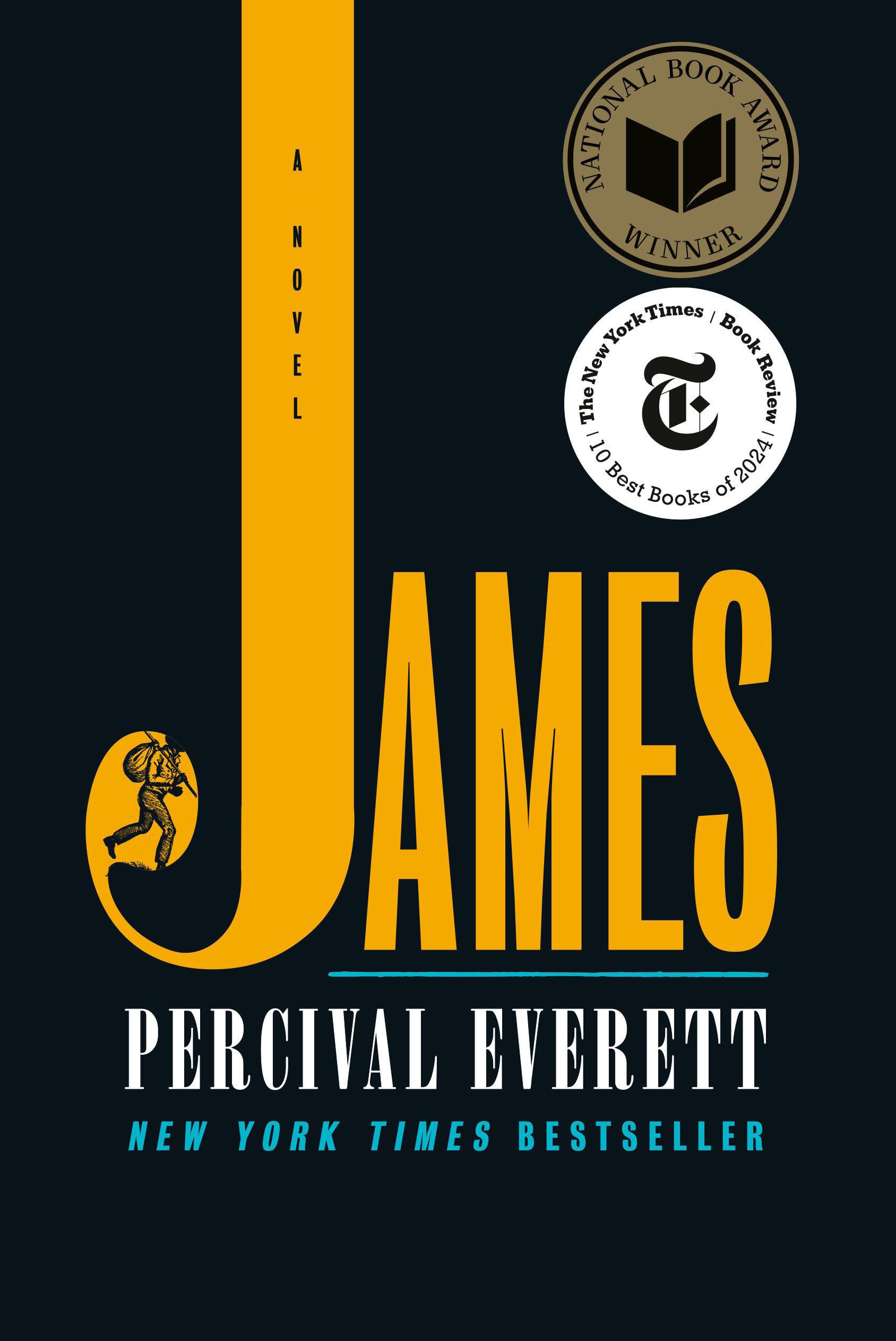
Review: The newest dark comedy, ‘Companion,’ brings our biggest fears to life in a world of everadvancing technology
Once again, men prove to be absolutely terrifying
BY SAVANNAH ANNO arts@theaggie.org
With a pastel pink title card, dreamy doo-wop music and a grocery store meetcute in the very frst scene, the structure of “Companion,” as a whole, perfectly encapsulates the relationship between its two main characters. Iris (Sophie Tatcher) is beautiful, endearing and dedicated to her seemingly lovable and witty boyfriend, Josh (Jack Quaid) — but of course, about 15 minutes in, it all turns out to be a ruse. Perhaps the movie’s biggest mistake, “Companion” gives away its most exciting twist in its trailers and promotions — look away now if you still haven’t seen the movie
thinking it’s all about sex — it delves deeper into each woman’s motivations behind sex, their deep desire for love and the fear of being vulnerable.
Each character has a unique and diferent personality that shapes their relationships and friendships: Carrie is obnoxiously self-absorbed, Miranda, the most judgmental, Charlotte, more conservative, and Samantha, unapologetically promiscuous. Tough their personalities may seem contradictory, these dissimilarities make the show better, as every viewer can resonate with a bit of each woman.
Isabel Resto, a second-year animal science major, watched the show for the frst time last year and found it made her refect on her own relationships.
“Te show made me realize that I should not be putting up with stuf like that, and at the end of the day, a guy is just a guy, and sex is just sex, and one day you’ll fnd someone you love, and they will rarely be perfect,” Resto said.
“I love how much it highlighted how heavily the girls leaned on each other, and it made me refect on how much I lean on my friends but that it is okay because that’s what friends are for, and I am always here for them to lean on.”
Remali De Silva, a fourth-year
— revealing Iris to be a robot, one that Josh purchased and programmed to act out his idea of the perfect girl. For viewers who went into the flm blind, the reveal was rewarding. As Josh takes Iris to a remote house in the woods (of course) for a weekend away with his friends.
Director Drew Hancock does a fantastic job of not entirely giving the twist away, but making sure that things feel… of Te way Iris walks, talks and is able to tell Josh the exact temperature at any moment ofers an eeriness that all builds up to the very frst moment where, in a panic, Josh audibly commands her to “go to sleep.” Not only does she go to sleep, but her eyes roll back into her head as she powers down.

While it was disappointing to have the big twist taken from you, the other half of viewers who knew what was coming were also able to enjoy the hints and puns Hancock embedded into the frst couple of scenes. While Josh’s cast of friends — the deeply-in-love couple Eli and Patrick, the snide Kat and the owner of the house, Sergey — are all in on the secret, so is the audience, allowing them to pick up on things like why Kat is so unsettled by Iris’ presence.
“Companion” hits the mark when it comes to balancing comedy and murder, with the audience sure to laugh at least once during every scene. Where it falls short, however, points to a glaring issue in its ability to provide depth to the main theme at hand: how men view and treat women.
While Iris’ existence as a robot allows audiences to easily connect the dots to a feminist lens, the horror of the idea feels overshadowed at times. Small moments like Iris realizing Josh had her intelligence setting programmed to 40% or him reasoning his purchase of her by saying, “It’s so hard to be a guy like me” (a straight, cisgender, white male), are lost in a sea of frenzied action and comedy, rather than giving audiences time to actually contemplate their signifcance to the reality most women face on a daily basis (without being robots).
Tis, of course, could be excused by the argument that “Companion” doesn’t need to be a serious critique of the way men view women — disposable machines they dream of completely controlling — as other flms and works already do that. But, the idea of excusing a flm as being “just for fun,” when it simultaneously parallels domestic abuse relationships, shows Iris losing her autonomy and touches on sexual assault, doesn’t seem right.
Hancock being another straight, white male and the movie being created by an allmale crew — except for the set decoration, wardrobe and makeup leads, of course — “Companion” makes you wonder what it could have been shaped into if directed by a woman instead. While ending in female empowerment, as Iris kills Josh with a wine-opener — reclaiming her power by, in turn, treating him as an object for once — “Companion” focuses more on the robot and less on women, refecting its attempted themes right back at its creators.
UC Davis students share contributions of transgender individuals, contemporary rhetoric surrounding transgender rights
BY EVELYN SANCHEZ features@theaggie.org
Te political climate has presented a troubling and frightening time for many communities in the country. With extensive immigration policies and widespread misinformation, underrepresented and marginalized communities have had the most to lose.
One specifc group targeted recently has been the transgender community. Legislation specifcally concerning the Trump Administration and how it might impact students immediately and longterm has been a topic of conversation. One of the more recent bills passed, AL SB79, outlines a standard for sexbased terms and requires the assigned gender at birth to be legally reported on documentation. President Donald Trump also recently signed an executive order titled “Keeping Men Out of Women’s Sports,” specifcally barring transgender women from competing in women’s athletics programs.
“Transgender people have been around since the existence of humanity,” Newts Henkel, a frst-year wildlife, fsh and conservation biology major, said. “Tere’s documentation of trans people in cultures all around the world. Until now, there hasn’t been a necessarily defning name for those people, but in a lot of places historically, trans people have been signifcant religious and social leaders in society.”
Te Navajo ‘nádleehi’ was a term for gender-fluid individuals in the Diné culture who existed outside of the traditional binary. As many as 150 pre-colonial Native American tribes recognized and integrated transgender or gender-nonconforming individuals within their communities. The Indigenous people of Oaxca’s Zapotec culture also held non-binary individuals in a very high regard, their cultural term for them being ‘muxes.’ Tey would adopt traditionally feminine work such as embroidery and decoration.
“[Transgender people are] acknowledgments of change and things that exist beyond our understanding and what is readily apparent,” Henkel said. River Baker, a second-year political science and philosophy double major, also commented on the dominant role
that transgender people play in terms of all queer rights.
“[For] a large portion of our rights, if you start taking away queer rights, you start the process of taking all of them like a domino efect,” Baker said. “In terms of the queer community, trans individuals play the dominant role in [queer people] having rights at all. If you take away trans rights, you take away all [queer] rights.”
On Jan. 7, 2025, Oklahoma passed a resolution, OK HR1002, regarding restroom access for transgender individuals.
“Only a person born as a biological female shall be allowed into any restroom facility which is designated for female members of the Oklahoma House of Representatives, except as authorized for the operations of the House,” the resolution reads.
Tis legislation is one of many examples fueling rhetoric based in bioessentialism, the belief that people’s most important characteristics are controlled by biology and cannot change.
“I’ve been trying not to look at the news,” a second-year student, who wishes to remain anonymous, said. Tere’s nothing I can do about these things, so why should I let it take up much of my mind?”
Henkel continued by sharing signifcant contributions that have been made by transgender individuals.
“Quite a few trans women have made significant contributions to technology,” Henkel said. “Trans people have been contributing to society regardless of identity, but I feel like trans people because of their identity are important. We are the embodiment of what can be and free choice and possibility.”
Transgender people have contributed to many important forums, from technology to activism. Lynn Conway designed very-largescale integration (VLSI), which is the process of embedding hundreds of thousands of transistors into a single chip, transforming the global microelectronics industry. Sylvia Rivera founded Te Gay Liberation Front and her participation alongside transwoman Martha P. Johnson during the Stonewall Riots was pivotal in asserting LGBTQ+ rights across the country.
Students and faculty discuss the lack of accessibility for affordable technology on campus
BY JENEVAH HARRISON features@theaggie.org
In an era where sustainability is at the forefront of many conversations, the accessibility of refurbished and secondhand technology remains a challenge for UC Davis students. While initiatives like the TechHub on campus provide repair services and fnancing options for new devices, students seeking afordable used technology often fnd themselves with limited choices.
For students who cannot aford a new device, UC Davis does ofer some temporary solutions. Te campus library provides laptop rentals for up to four hours daily, ofering short-term access to technology. Additionally, students in fnancial need can request a computer loan through the Financial Aid and Scholarships department. However, both options come with limitations.
A loan, while helpful, still requires repayment after graduation, which may place a fnancial burden on students. Similarly, a four-hour rental period is far from ideal for full-time students who rely on a device for extended periods throughout the day.
Recognizing the fnancial strain of purchasing new devices, the TechHub repair team ofers an alternative for students looking to maintain their current devices.
“Aside from payment with cash or card, we do allow students to pay for their repairs via their Student Account in which they can pay for the repair the same way they would pay tuition through MyBill,” the TechHub repair team said via email. “Tis allows for some flexibility to students who may not have the direct means in paying for the repair upfront.”
For students interested in upgrading their devices, TechHub Manager Patrick Khamvongsod highlighted the store’s trade-in program.
“If students are looking to upgrade their devices, we have a trade-in program,” Khamvongsod said. “You get the value of your device, come to our counter, we take your old device and issue you a bookstore gift card. Most of the time you would use that credit towards another device purchase.”
While this program provides an option for students looking to upgrade, it does not directly address the lack of afordable technology for students.
The Aggie Reuse Store, which promotes sustainability by providing free, used items for students, currently does not serve as a resource for used technology, noting that they typically only receive items such as clothing and houseware. Besides a few AirPods cases, the store was predominantly stocked with non-technology items.
Tis gap highlights a signifcant issue: While students may be willing to donate or sell used clothing and household goods, there is no established culture or system for recirculating technology on campus.
Phoebe Anzalone, a second-year American studies major, shared her frustration with the lack of options for purchasing used technology on campus.
“Everything on campus pushes you toward buying something brand new, whether it’s a laptop, charger or tablet,” Anzalone said. “There’s really no alternative unless you go off campus or find something on Facebook Marketplace, which isn’t always reliable.”
Tis sentiment underscores the broader problem within the UC Davis community of single-use culture surrounding technology. Without a structured program to encourage the reuse and resale of electronic devices, students are left with few sustainable and afordable choices.
“I recently had to get my computer replaced and for the days it was broken, I fell behind on my classwork,” Anzalone said. “I tried going to TechHub, but due to insufcient stock, I wasn’t able to get
a new device for at least a week. Not to mention there really isn’t much of a discount for students, and I defnitely think that should change.”
A potential solution to this issue could be the implementation of a used device initiative at UC Davis and possibly UC-wide, according to students like Anzalone. Establishing a formal marketplace for secondhand technology for enrolled students would make essential devices much more accessible while also promoting sustainability. Such an initiative could involve a designated campus store or online platform where students can buy and sell used laptops, tablets and other tech accessories.
Anzalone further shared her experience at the UC Davis TechHub.
“Even with the student discount, I think they try to make it more accessible,” Anzalone said. “But $100 dollars of of a $1300-1400 computer isn’t really much more accessible, in my opinion.”
Tis student discount, a promotion provided by Apple and not the university, is not entirely sufcient, according to Anzalone. An alternative solution to this could be a discount provided directly through the university rather than a private company to ensure sufcient accessibility for students.
UC Davis students have proposed several potential initiatives to enhance access to affordable technology and reduce electronic waste. Tese suggestions include creating a secondhand tech marketplace, expanding the Aggie Reuse Store’s inventory to include electronics or establishing a formal system for students to sell or donate used devices.

“I think considering the universities commitment to sustainability, it defnitely makes sense for there to be second-hand technology available for students,” Anzalone said. “It seems like a winwin situation to me if UC Davis were to implement this type of program.”
Implementing such programs could increase the availability of cost-efective technology while also supporting waste reduction eforts and sustainability goals. Expanding this access could potentially further promote UC Davis’ sustainability practices and commitment to equal accessibility for their students.
Students open up about their social and academic backgrounds as they navigate college
BY AMBER WARNKE features@theaggie.org
College can be challenging for many students, with balancing social life, academics and work experience proving difficult across majors.
Neurodivergent students, however, may face unique challenges as they encounter a system that was designed around a diferent way of processing.
Neurodivergence refers to people who process information in an “atypical” way, including disabilities such as dyslexia, dyspraxia, attentiondefcit/hyperactivity disorder (ADHD) and autism, according to Northwestern Medicine. An estimated 10 to 30%
of students in higher education are neurodivergent, which can lead to struggles with sensory processing, time management, attention and social diferences.
Emmy Gallagher, a third-year biochemistry and molecular biology major, said that being autistic has led to them experiencing the social side of college di f erently than some of their peers.
“I think it’s defnitely made it more challenging to make friends, because I get very stressed out sometimes, going to social events,” Gallagher said. “I feel like there’s a lot of unwritten rules about things that you just kind of have to fgure out.” Social rules can be difficult
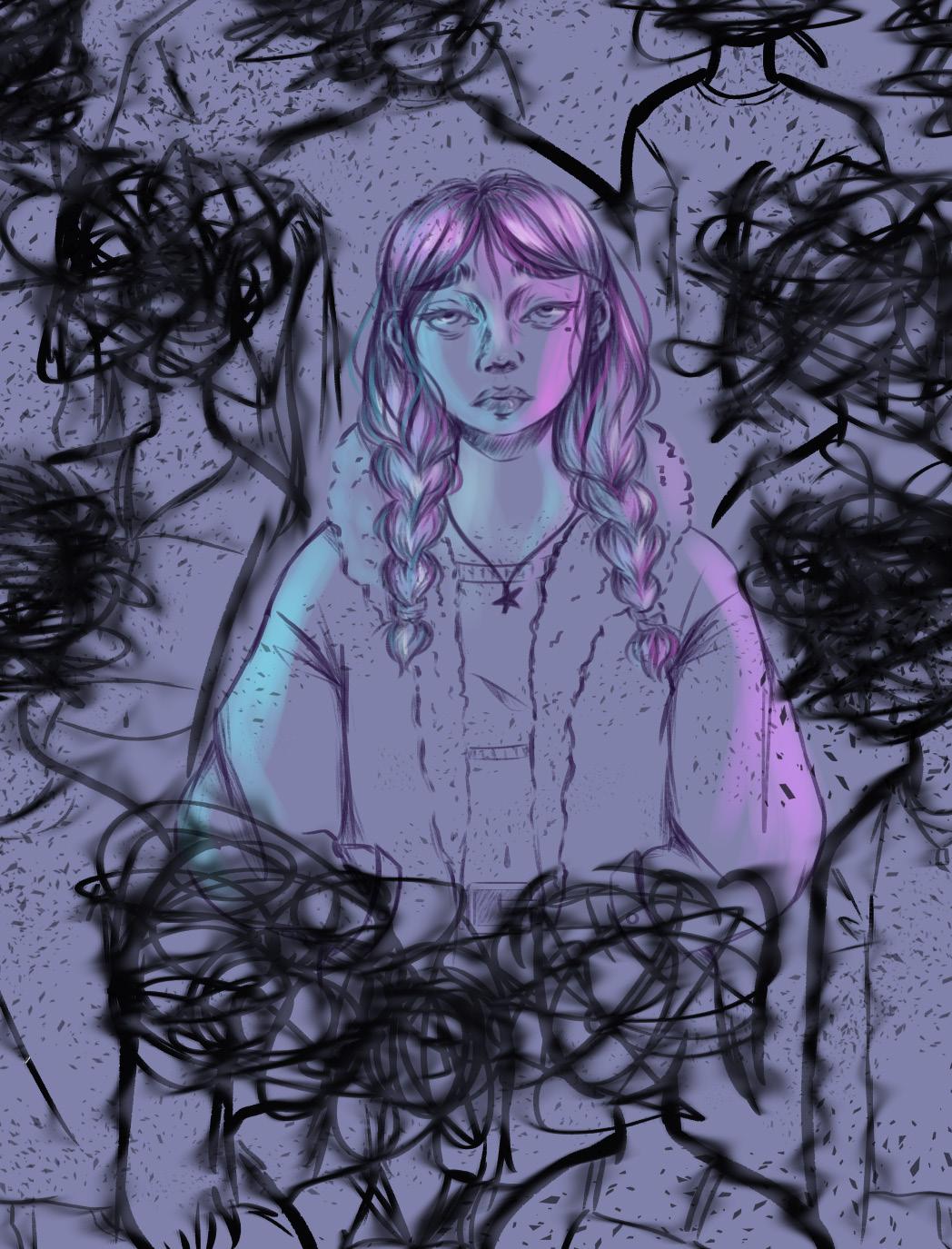
to navigate, especially when contemporary culture sometimes emphasizes politeness over genuineness — such as when people say they “Should meet up for cofee sometime!” when they run into one another, only to never set a date.
Tis is something Erin Burnett, a third-year neurobiology, physiology and behavior major, relates to having a difcult time navigating.
“Social niceties just confuse me,” Burnett said. “I kind of can act on them the wrong way and it can be misinterpreted.”
Burnett, who has ADHD, autism and obsessive-compulsive disorder (OCD) tendencies, is the event coordinator for the Aggie Neurodiversity Community. Being a part of this community is something that has helped her navigate the social aspect of college and has allowed her to meet with other students to celebrate being their true selves.
Gallagher said that being a member of the Aggie Neurodiversity Community has also helped her navigate collegiate social life.
“It’s just really reassuring to see people who also are dealing with similar challenges and see that they are going at their own pace, and they’re still being successful and doing what they want to do in life,” Gallagher said.
A second-year English major, who wishes to remain anonymous, has ADHD, autism, antisocial personality disorder (ASPD) and post-traumatic stress disorder (PTSD). Te student spoke about their experience with people who might not initially realize that they are neurodivergent.
“If people don’t even know you’re autistic, they can still tell there’s something weird about you,” the student said. “If someone doesn’t ft with how [others] think they should be, they’re going to be weird about it.”
Tis can be especially challenging in college, where quick judgments can often be made in social interactions — considered an integral part of the college experience. T e student shared how students can create a more welcoming environment not only for neurodivergent students, but for everyone.
“Everyone’s a goddamn person, and everyone’s fucking weird,” the
student said. “You don’t have to know what their disability or what their shit is, what’s going on. Assuming everyone is trying their best is something that helps me. Like, I’ve got no empathy, but I have a lot of compassion.”
In addition to socializing, academics can also be challenging for neurodivergent students in a system designed primarily for neurotypical, lecture-format learning styles.
Burnett has especially been impacted by the sensory di f culties tied to autism.
“Tere was one fnal — I remember crying and having to say, ‘I need a second,’ because the lights buzzed,” Burnett said. “I got to experience just how difcult it is to go without accommodations. And then I was fortunate enough to receive them and see how much better it could be. To have captions during a lecture or [to] be able to take an exam after having cried during that fnal to be able to not have to cry during exams because of sensory issues, because I [now] take them at the accommodating exam center.”
Te anonymous student’s multiple disabilities also pose unique challenges as they navigate college academics.
“ADHD makes it hard for me to focus, which is kind of a given,” the student said. “But because of the mixing with the PTSD, I have a very high threshold for the panic that needs to happen to get things done.”
The anonymous student also said that the main thing that helps with this is proper medication, which can be di f cult to secure for some students, as the UC Student Health Insurance Plan (SHIP) does not cover stimulants. Additionally, many stimulants have been impacted by continuous shortages since 2022, according to the American Journal of Managed Care, leading to further difculties accessing medication.
Part of Gallagher’s academic journey has been gaining a greater acceptance of their college trajectory.
“Some stuf is just going to take a while, or it’s going to take longer for me to do,” Gallagher said. “I’m going to have my own path and go at my own pace.”
Te anonymous student suggested ways the university could better
support these students, who may require more self-paced academics, rather than a standardized academic trajectory. T ese students may also require further resources like more visual aids, extended time for testtaking or more concise instructions. Te student also provided a message to other students experiencing similar difculties.
“If you want to facilitate learning, you have to facilitate growth, not just constant [focus] on deadlines,” the student said. “Whether or not the school system supports you is not a measure of your worth, I promise.”
Te anonymous student went on to suggest that if all professors gave partial credit for late work, recorded their lectures and allowed test retakes, not only would neurodivergent students potentially be better academically supported, neurotypical students would as well.
Course flexibility may be especially helpful to acknowledge the varying accommodations that neurodivergent students may beneft from. It is generally recommended to implement inclusive learning practices and Diversity, Equity and Inclusion principles, individualize learning practices when possible and provide clear and transparent course instructions, according to the eLearning Industry.
While one student may need assistance with the socializing required for group work, for instance, another may have executive functioning challenges and bene f t most from extended deadlines. Neurodivergent students are not a monolith, as these students have shared, and two students with the same disability can experience vastly diferent challenges.
“If you’ve met one neurodivergent person, you’ve met one neurodivergent person,” Burnett said.
However neurodivergent students opt to manage their disabilities, and whether it’s through seeking community with students who can relate to their challenges, pursuing academic accommodations or practicing self-acceptance — their perspectives and experiences are integral to the diversity of the UC Davis community.
Enter digits from 1 to 9 into the blank spaces. Every row, column and 3x3 square must contain each digit. Each Sudoku has a unique solution that can be reached logically without guessing.
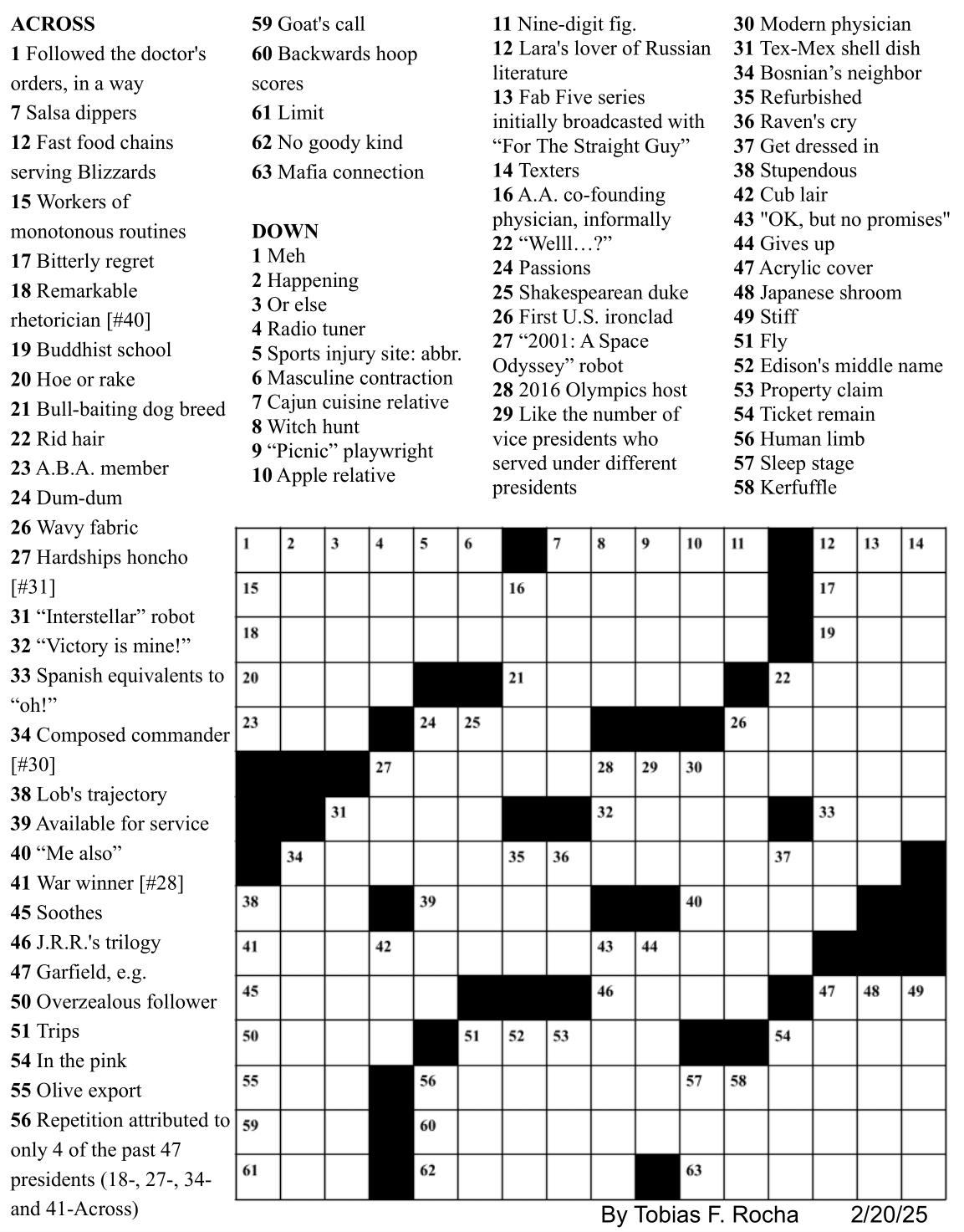
the standards that I’m holding other students who don’t have to navigate what that is and what that looks like.”
“It is important for institutions to be ready and prepared for the potential worst.”
Although Aldana hopes that Drake will implement these directives, she also asserted that individual faculty members and students can make changes on their own.
Tere’s limitations in what we can do as individuals, but there’s also possibilities — especially in the collective,” Aldana said. “We look to administrators as being the only sights of solutions, but we give up too much agency and too much power when we only seek solutions from the top. We are the institution. Each of us.”
Dr. Veronica Lerma, an assistant professor of sociology at UC Davis, has a research focus on criminalization and intersectionality. Lerma believes that supporting students through this period is incredibly important.
“I recognize the harm that the Trump Administration’s immigration policies, particularly those that emphasize mass deportation and family separation, have on students and their families,” Lerma said. “Te letter just aligns with my ethical and professional commitment to support and stand with and advocate for my students, especially those who may be the most marginalized, which includes undocumented students.”
At a high-level institution such as UC Davis, it is easy for academic pressures to mount. When coupled with real-world concerns about the future for undocumented students, it can become increasingly difcult to maintain the level of academic performance expected of UC Davis students.
“I have students who are maybe in class, but they’re not really ‘there,’ right?” Lerma said. “Doing the things that they need to do as students to succeed in school is kind of like the furthest thing from their mind when they’re worried about whether they’re gonna lose their family or whether or not they’re going to be here. I think it’s unethical to hold those students to
In response to these concerns, Lerma hopes to alleviate some of the academic pressures for her students who are experiencing increased stress levels during this time.
“Just giving them grace in this moment has gone a long way,” Lerma said. “Tat means fexibility with turning in assignments or even sometimes just being an ear to have a conversation.”
Te policies proposed in the letter aim to give undocumented students and their families long-term security and support in the face of an uncertain next four years. Lerma hopes that these actions, coupled with support from classmates and faculty, can help provide solace amid the uncertainty.
Sometimes, she said, this just looks like making it through another day.
“If they’re surviving today, that’s enough,” Lerma said.
From organizations to non-profts, there are numerous ways to help out and become a blood donor in Davis. Vitalant commonly hosts blood drives at varying locations across Davis to encourage all residents to come out and donate. Additionally, UC Davis Health partners with the American Red Cross to host blood drives and take donations. Teir next drive will be on the UC Davis campus on April 10. However, giving blood is not the only way to help out against blood shortages. Vitalant volunteer and Meghana Tummala, a frst-year human biology major, explained how to get involved if you are unable to donate.
“If you’re not able to give blood yourself, the best way to get involved is by fnding clubs and organizations that get involved with blood drives and events,” Tummala said. “Another great way to help out is to help educate other people about giving blood and if
they can potentially be donors.”
With the blood shortages presented by the unpredictable weather of February, blood donors are more in need than ever and blood drives are popping up all across Davis. Check out upcoming blood drives from Vitalant, Davis Odd Fellows, UC Davis Health and more.
“I feel that deleting your account is a very political statement that shows you are politically engaged,” Wojcieszak said. “It is actually likely to increase your well-being because you’d be exposed to less negativity, but you need to get into a habit of, say, having your homepage show the New York Times, Te Washington Post, CNN, Fox or wherever you get your news. Otherwise, if you do see news on the platforms and then you delete it, it is possible that you then think you’re living in a blissful reality.”
Katherine Krinsky, a fourth-year English major, said she strives to fnd balance. She tries to stay away from social media due to its addictive nature and overexposure to what she sees as excessively negative content, while still ensuring that she is politically engaged.
“I realized that I wanted to prioritize being informed on what’s happening but on doses that I can control more,” Krinsky said. “Rather than getting sucked into ‘doom scrolling’ on Instagram, I have gotten into the habit of listening to NPR news podcasts every morning and spending some time at the end of each day reviewing the headlines from the New York Times. I feel like I’ve been able to manage the energy that I give to my news intake instead of being overwhelmed by the intensity of the news I’d see on social media.”
Social media, particularly for Gen Z individuals, serves as a means of communication with others, education on current events and a way to keep up with trends. Without it, one may feel disconnected and less informed about the world, especially for those who primarily rely on social media for news
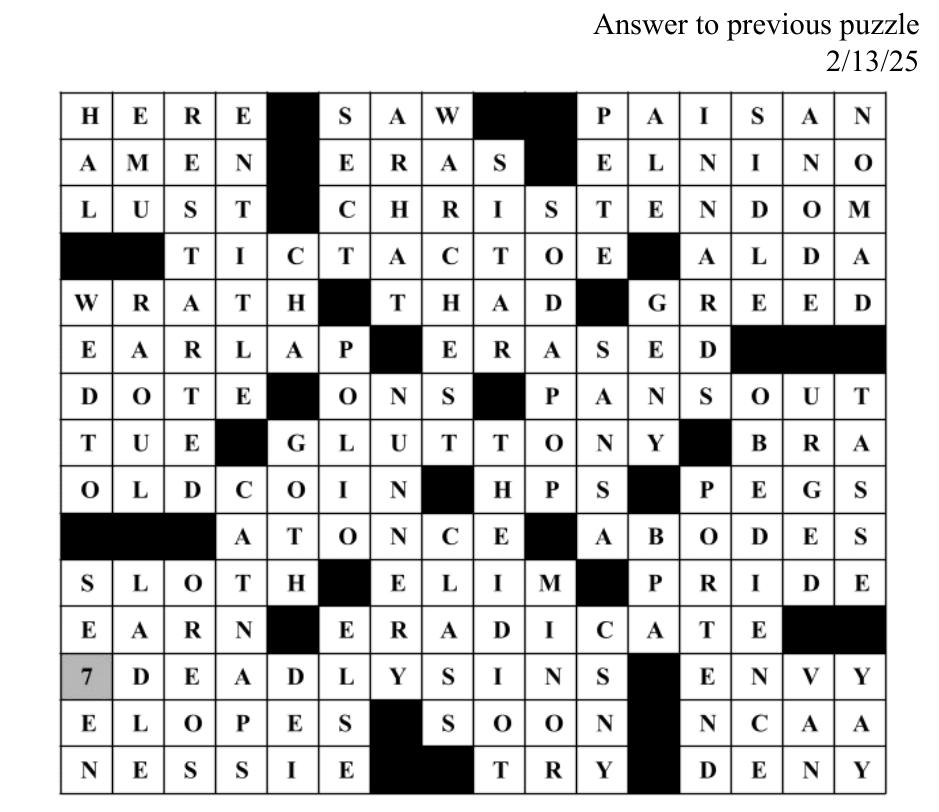
coverage. Deleting it therefore may have both social and political consequences, as users may be generally less exposed to informative content.
However, Wojcieszak said that those who do rely on social media for news information may be exposing themselves to overly negative content.
“Tere is research that shows that news that is shared on social media platforms is way more negative than the news that is posted on the website,” Wojcieszak said. “Say, for instance, someone goes to the social media page of Te Washington Post — the articles that they decide to share are way more negative in tone than what is actually available on the website.”
Wojcieszak explained that the content that tends to get the most traction on social media sites — shares, clicks and comments -– tend to be stories with a negative or disheartening edge. Due to this pattern, the sites have more incentive to continue to post similar content.
“My work shows once it is [posted] on the platform, what is then being shared and gets the most engagement is negative and [tends] to be things that attack the other side,” Wojcieszak said.
“If you are one of the few people who get their news from social media, you are exposed to more negativity, confict and polarization than you would be just by going to the home page.”
Though it can be discouraging to view content that tends to be overwhelmingly negative, Wojcieszak emphasized the importance of being politically engaged and viewing news content -– a trait that she has found to be in small numbers through her research on political news avoidance.
“People fnd news overly negative, overly confictual, overly focused on drama, polarization and whatnot, and that is said to turn many people away from news,” Wojcieszak said. “But the reason the negativity in the news is the reason to not watch news applies to not many people — it applies to people who used to consume news or who want to consume news. In order to be negatively afected by negativity, you need to be actually engaging with news — that reason for news avoidance pertains to actual news users. Which brings me to the majority -– the majority of people just don’t care.”
Wojcieszak suggested to younger individuals to involve themselves in the political realm as much as possible, stressing the importance of connecting current events to our daily lives.
“I am worried that the younger generation is withdrawing from politics altogether,” Wojcieszak said. “I ask that you guys don’t do that — it’s so easy to not notice how much everything that is happening in Washington impacts you. It’s really easy to say, ‘It’s something over there, it has no relevance to my life’ — but [it] actually does.”
“We have a Citrus Fest where we’re going to have four of our local citrus farmers come and interact with
customers, answer questions and let people try the citrus from their farms, as well as the varieties we currently have at the co-op. We’ll also have recipes for people to try, and citrus experts from the California Department of Food and Agriculture talking about the importance of citrus groves and how community members can care for their own citrus trees.”
With the return of community barbecues and more engaging local events, the Davis Food Co-op continues to serve the community, fostering connections and providing residents with sustainable, high-quality food.
Audience members were invited to ask the legislators questions. One audience member asked how the legislators, who represent minority parties in both the California State Senate and the California State Assembly, lead in their roles. Gallagher said he lobbies everyone in the committee to fnd common ground on policies. He gave the example of securing one billion dollars’ worth of funding in the aftermath of the 2021 Dixie Fire.
“I think that was a lot to do with the minority party pushing the issue and also fnding alignment with Democrats to get that through,” Gallagher said. “Te negative is, ever since that time, the budget has slowly decreased and we need to get it back up. But there’s defnitely those opportunities, even in the minority, to be a part of moving substantive change.”
More information on upcoming performers and authors can be found on their website.
“Our commitment to literature, live performances and the vibrant culture of our city is the driving force of our eforts,” the website reads. “Behind the scenes is a collective of talented and diverse community members, each of whom believes that there is nothing better than hearing authors and actors live. We hope you’ll join us for ‘Second Sundays at Sudwerk.’”

Students at UC Davis share the negative effects that ICE has had on themselves and their loved ones
BY GRACIELA TIU features@theaggie.org
Recent increases in Immigration and Customs Enforcement (ICE) raids and mass deportation rhetoric have afected a multitude of people and communities, including some at UC Davis. Tough Davis is a sanctuary city — in other words, individuals’ document status is not taken into consideration when interacting with police ofcers or local ofcials — this does not prevent entry or action from ICE.
For many students with connections to this topic, the uncertainty surrounding these policies and actions can be difcult to cope with. Several students, who preferred to remain anonymous due to the sensitive nature of the topic, shared their experiences with Te California Aggie.
One student discussed the direct impact of ICE raids in their hometown.
“I learned about the ICE raids
because, in our close-knit community, word spreads quickly,” the student said. “As soon as the frst sighting of immigration agents was reported, everyone knew about it. People would warn each other, making sure everyone stays safe. Our community has always looked out for one another, especially when it comes to situations like that.”
Te frst anonymous student continued by commenting on the constant uncertainty that many people are feeling. “Tese events hit deeply — not just for me, but for everyone in my community,” the student said.
“Knowing that ICE raids could happen at any moment creates an overwhelming sense of fear and uncertainty. It’s not just an abstract threat — it’s a reality that afects families, friends and neighbors.”
A second anonymous student described the difculty and exhaustion of having to cope with these fears while also adjusting to college life.
“I’m defnitely a lot more drained than I would normally be, or at least more than I have been in a
while,” the second student said.
Tey also noted how being away from home makes hearing news about recent ICE escalations and mass deportations even more challenging.
“I feel like it causes more stress,” the second student said. “I’m already having a tough time not being home, but I remind myself that other people have to go through this too, and I’m doing this for me and my family, so it’s okay. But now that this is happening, it’s another fear on top of everything else. I don’t know what’s going on back in my hometown since I’m not there, and there’s nothing I can do about it.”
Te repercussions of these uptakes in immigration enforcement afect people in various ways, with some feeling unsure about when and where ICE is allowed to operate and what potential threats truly look like for individuals’ immediate and distant futures, according to a third anonymous student.
“I’ve heard my friends be afraid of not even being able to fnish their college education,” a third anonymous student said. “My family members
give UC Davis students the chance to learn about
Brian Pearson, Devavrata Das, Suvarna Bindu Das and other monks arrive in Davis to share Hindu teachings
BY NOAH HARRIS
features@theaggie.org
Te unassuming house sits in a small corner of Davis, on B Street and E 8th Street. Tere are no decorations outside, no signs to lead any wanderers to it. However, inside its wooden walls flled with colorful artwork and books for sale contains monks taught in India, devoted to the Hindu deity Krishna.
Tese men, two of whom are from Orange County, moved to Davis around a month ago, and seem to be one of Davis’ most unique gatherings. Tree of the monks, who outlined and shared about their practice, are Brian Pearson, Devavrata Das and Suvarna Bindu Das.
Every Tursday at 6 p.m., an event called Wisdom Talks is held at 400 E 8th St. If one arrives late, they will be greeted by a loud chanting sound coming from a very small group, typically around 10 people.
Te chant, named Hare Krishna, goes: Hare Krishna, Hare Krishna, Krishna Krishna, Hare Hare, Hare Rama, Hare Rama, Rama Rama, Hare Hare.
Charlie Zivny, a fourth-year economics major who has attended multiple Wisdom Talks, shared his initial thoughts on the event.
“I walk into the alleyway and I hear the drums and the ringing and, I’m like, okay, there’s some rhythm going on,” Zivny said. “I get there and there’s this glass door and I see people sat in a circle. Te inside of the house is kind of like this wood, and it’s dimly lit with orange lights. If you like video games, it was like you entered a new zone that you just unlocked.”
Before entering, people must take of their shoes, and most choose to sit on the foor even though there are chairs available. Te chanting, which is a prayer to Krishna, repeats over and over again for around 20 minutes.
Pearson, one of the monks from Orange County, further described the weekly Wisdom Talks.
“We have a talk session on spiritual wisdom from Bhagavad Gita, the ancient Vedic literatures,” Pearson said. “After that, we have an ecstatic vegetarian feast or plant-based feast. Te best food you’ve ever had.”
Zivny described what he was feeling when he frst arrived.
“At frst, [it was] really uncomfortable — it [may] feel culty
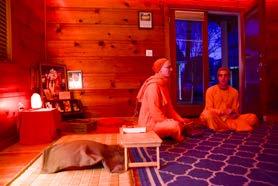
[to some],” Zivny said. [However], if you’re gonna do something, commit to it. It’s not trying something new if you only put one ass cheek on it, it has to be both.”
Zivny ended up enjoying his experience and went back the next week.
Next, the dancing portion of the night begins. A circle forms, and hands are thrown in the air as participants loudly sing the same Hare Krishna chanting that started the night dozens of times. After some time, the dancing ends and dinner is served.
Te monks can be found in various places around UC Davis during the day, such as the Memorial Union and Silo. Tey traditionally wear orange or white robes and are typically clean shaven, except for small ponytails on the backs of their heads.
While they moved to Davis with the intent of speaking with college students, Das, one of the monks, explained that they don’t want to force students to afliate with their religion.
“Whatever tradition one may be from, whether they’re Christian, Jewish, Muslim or whatever their background is, anyone can come — because the purpose is not conversion, the purpose is education,” Das said.
Another reason for coming to Davis was that there are very few universities where those interested can learn how to be “Krishna conscious.”
“Krishna consciousness — for one to make progress in that education, one needs to engage in service,” Das said. “Tere’s no facility for [Davis students] to actually be educated in Krishna consciousness or selfrealization.”
Pearson expanded more on the efect that he wanted Wisdom Talks to have.
“It’ll have a really big impact on society if we’re able to, you know, kind of inculcate this ancient wisdom, which we’ve seen has benefted not only our own lives, but those who we know are also practicing and those in the past,” Pearson said.
Tey traditionally broadcast live videos on their Instagram account.
While devotees of Krishna are technically a branch of Hinduism, they consider themselves monotheistic, and only pray to Krishna. Traditionally, devotees believe in concepts such as karma and reincarnation.
Das explained the frst part of his daily ritual, which included going to sleep early and waking up early.
“I wake up at 3 a.m., but most of us wake up at 4 [a.m.],” Das said. “We come into the temple, and then we start our personal meditation.”
In their house, they have many religious and informational books for students to buy. Tere are also beaded necklaces for sale, which in total have 108 beads, each one symbolizing one run through of the chant that they sing during their Wisdom Talks.
“We chant the full mantra around the beads 16 times [per day],” Das said. “We’re so active all day trying to serve, when we sit down to chant, generally we feel the reciprocation from our service in the joy we experience while chanting.”
In total, they chant the Hare Krishna, which is 16 words, approximately 1,728 times every day.
UC Davis students reflect on “Wipeout” and how the game show shaped humor and childhood memories
BY JALAN TEHRANIFAR features@theaggie.org
Tere are a lot of things that seem to defne Gen Z — existential dread, an obsession with saying “slay” and an ability to diagnose obscure psychological conditions based on one TikTok video, to name a few. But if there’s one thing that truly unites them, it’s growing up watching people get absolutely wrecked by giant rubber balls. Enter “Wipeout,” the game show that turned slipping, tripping and face-planting into a competitive sport, shaping Gen Z humor for eternity, according to UC Davis students and beyond.
Sure, Wipeout was just a show where people willingly launched themselves onto unstable platforms while two hosts made dad jokes about
their misfortune. But for Gen Z? It was so much more. Tis wasn’t just television — it was an art form in the hearts of many. It was survival of the goofest. It was the backbone of their childhood entertainment. And, quite frankly, it taught some valuable life lessons. For many, “Wipeout” was a core memory. It was considered a perfect after-school show — mindless, hilarious and requiring absolutely zero emotional investment. Whether Gen Z kids were eating Goldfsh crackers on the couch or avoiding homework, “Wipeout” was there for them. To Nava Regev, a fourth-year political science major, “Wipeout” wasn’t just a silly show, it was a lifelong dream.
“When everyone still had cable TV and ‘Wipeout’ was at its peak, my brother and I would sit and watch episodes for hours and we would make fun of everyone who wiped,” Regev
express fear but also, in a way, defeat — because if this is what this country has come to, then why even stay?”
Te third anonymous student discussed the increase in outward bias toward people of color as a result of the current administration’s deportation rhetoric.
“I defnitely think that given recent events, people feel that they can be openly racist,” the third student said. “I was part of the UC Davis Sin Fronteras protest, and that’s when I personally felt the change. So many people fipped us of while we walked.”
Given these recent events, students at UC Davis have been able to seek a level of comfort from community members within protest and various activist groups.
“It’s nice to see that there is a sense of community and unity within college campuses and that people recognize what is going on is not okay,” the second student said.
Given the deep impact on many students’ well-being, according to students, some are looking to the university for support and guidance.
Te frst anonymous student said the response from UC Davis has not felt sufciently helpful.
“I truly feel that the university has failed us,” the frst student said. “UC Davis has been shockingly silent in a time when its students need support the most. Even when we reached out, the university couldn’t ofer any real assurance.”
With the continuation of ICE raids and a steady governmental push for mass deportation, afected students hope to see a sense of empathy and higher awareness from the rest of the community.
“I wish more people understood the trauma that these mass deportations are creating,” the third student said. “I guarantee you that we all have someone in our life who is an immigrant or cares about someone who is an immigrant. Te people being deported are only humans working and studying for a better life. Tere is no crime in working to get better.”
Bernadette Grace Albano and Rosie Mendoza discuss their band’s history and inspiration
BY LAILA AZHAR features@theaggie.org
Te musical duo Nineteenth Operator is the type of partnership that seems like it was meant to be.
Bernadette Albano, a fourth-year biological sciences major, and Rosie Mendoza, a fourth-year English and American studies double major, crossed paths early on in college.
Tey lived in the same dorm building as frst-year students, although they didn’t speak to each other much.
It wasn’t until they both found themselves in Cowboys After Dark — a well-known, local band in the Davis community — that they truly began to interact. Initially, however, the duo wasn’t exactly harmonious.
“She didn’t really like me much at frst,” Albano said. It didn’t take long for the two to put any initial friction behind them.
Tey had been talking about forming a band for quite some time before Nineteenth Operator came to life.
“We’ve been talking about doing this for about a year and a half, I’d say,” Mendoza said.
Going from being a part of Cowboys After Dark, a cover band, to writing their own music has been a change for them. However, they are enjoying the process of creating their own songs. Te two come from diferent musical backgrounds. Albano’s roots lie in theater, where she discovered her love for performing and singing, while Mendoza’s journey started with learning to play the trumpet, inspired by her older sister. She eventually learned other instruments such as the
ukulele and guitar, and began writing songs in her spare time.
Nineteenth Operator draws from a variety of diferent musical artists, such as 1990s dream pop artists Te Sundays, Mazzy Star and Te Cranberries. Tey additionally cite the narrative structures of Remi Wolf’s songs and Chappell Roan’s anthemic choruses as inspiration.
Albano and Mendoza have very distinct personalities, but they each show a deep appreciation for what the other brings to the table.
“I don’t think we have anything in common,” Mendoza said. “But I think that might be why we work well together. Because we’re so diferent.” Albano pointed out Mendoza’s creative spirit. “Rosie’s one of the most creative people I know,” Albano said. “She learned how to crochet in like a week and started wearing these clothes she crocheted just because she could. It’s incredible.”
Mendoza, on the other hand, noted Albano’s management skills.
“Bernie can bring to life any vision I have,” Mendoza said. “It’s amazing how she can grow the seed of whatever I plant.”
On Feb. 15, Nineteenth Operator performed at Secret Spot, an art and music lounge in Davis. Audience members were able to don the band’s “Girl of the Year” sashes.
Te next night, they delivered a stripped-down, acoustic set at Downtown Davis’ Armadillo Music, complete with an impromptu cover of Norah Jones’ “Don’t Know Why.”

said. “All I wanted to do growing up was be on the show — the obstacle courses looked so fun. I even had the ‘Wipeout’ game on my Wii — I think I still do, actually.”
Regev recently began rewatching “Wipeout” with her college roommates, hoping to relive the joy it brought her as a child. As she watched contestants wipe out in spectacular fashion, she couldn’t help but refect on her younger self’s confdence. “I used to be so high and mighty about it; I swore that if I were on the show I would complete the obstacle courses with no problem,” Regev said. “Rewatching it now, I probably would’ve been eliminated in the frst round.”
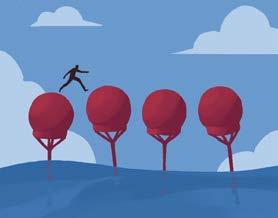
Midway through Regev’s nostalgic binge, curiosity struck — did the iconic obstacle courses still exist? A quick search revealed that not only were they still standing, but the show itself had been revived in 2021, now hosted by none other than John Cena. “When I found out the show was still running, I forced my friends to fll out a casting application for the 2025 cycle with me,” Regev said. “I am determined to make this dream come true; I don’t care if I embarrass myself on national television, this needs to be done.” After learning that TBS announced the cancellation of the “Wipeout” revival earlier just this month, Regev was devastated. Te news may have even hit harder than a contestant getting launched of the Big Red Balls. “My heart is broken,” Regev said. “I have class in 15 minutes, but now I have to just
WIPEOUT on 11
The UC Davis fossil collection has thousands of fossils, and the collection ranges over a billion years
BY KATELYN BURNS science@theaggie.org
Te UC Davis fossil collection is housed in the Department of Earth and Physical Sciences building. With thousands of fossils and a collection ranging over a billion years, there is plenty to see — including a giant sloth’s skull from the La Brea Tar Pits, which still smells of asphalt.
While UC Davis is one of the top public research universities, the fossil collection isn’t mainly used for research.
David Gold, an associate professor in the Department of Earth and Physical Sciences and curator of the UC Davis fossil collection, discussed the reasoning behind the fossil collection’s lack of research applications.
“Tere is research we can do with the fossils here but, a lot of times, if you’re doing research, you’ll really
xenophobic context we think of today. Since the medieval English period, this word instead has meant “foreigner,” or “not from one’s own country.” However, in the U.S., this word has become heavily racialized toward Latino immigrants. In Edwin Ackerman’s research, he found that “illegal alien” was frst used to label Latino immigrants during the 1960s as a way to replace a slur against Mexican people. Initially well-meaning, this word has grown derogatory through its use in anti-immigrant rhetoric.
Right now, in the face of mass deportations, word politics may not seem all that important — and honestly, you’re right for thinking that.
However, it feels like so much more than just words. It’s people who have built lives here, people who had kids here and people who just got here wanting to start their new lives — they all sacrifced so much to be in the U.S. and are vulnerable to losing it all.
People have already been torn from their families and communities, and even more people live in fear that it will happen to them or a loved one.
Yet, re-centering undocumented people’s humanity is why this conversation matters. The federal administration and politicians are reducing people to terms like “illegal,” “criminal,” “alien” and worse in ofcial statements, while simultaneously stripping people of their livelihoods, agency and human rights. Tis use of dehumanizing language attempts to normalize these extremist enforcement measures that afect real people.
We cannot allow mass deportation to become normalized, because this is not normal. People should not be living in fear of their own government because they don’t have the “right” papers. Te 14th Amendment should not be getting overturned because one guy said so. People should not be taken out of the home they have lived in for 20+ years.
I’ll leave you with the only two words I can think of to replace “illegal alien,” and that’s “Abolish ICE.”
Disclaimer: Te views and opinions expressed by individual columnists belong to the columnists alone and do not necessarily indicate the views and opinions held by Te California Aggie.
FROM PAGE 4
As in any sport or extracurricular activity, dance involves a lot of constructive criticism and mentoring. To be successful, you have to learn to use the corrections you get from teachers to your advantage and to not take them personally. It can be so challenging to keep criticism from getting to your head, but once I learned to take it as an opportunity to grow, I started to improve signifcantly. Instructors aren’t going to give you constructive feedback if they don’t think you’re ready to take it — if they don’t think that you can handle more difcult elements. Trough dance, I learned to take corrections as testaments to my abilities: they meant I was ready to grow. Physically, dance has given me a more thorough understanding of my anatomy and how my body works than any health class I’ve ever taken. I have a relatively solid grasp on human mechanics (at least for someone who has never formally studied it) and, while I’d never claim to be an expert, it comes in handy sometimes.
Dance also heavily infuenced how I exercise. For instance, I know not to static stretch before a workout because holding a stretch for more than a few seconds can temporarily deactivate
want to know where it was found precisely, who collected it [and] when, and often, we don’t have quite that much information,” Gold said.
With that data missing, the UC Davis fossil collection usually serves a diferent purpose.
“We have a teaching collection,” Gold said. “Typically, there’s some data missing. Not all of it, but some data missing that would make it hard to use for research purposes so we use it more for outreach and courses.”
Student interest is incredibly important to a department’s health and stability. Currently, the fossil collection is only used for two courses: Introduction to Geobiology (GEL 053) and Paleobiology Laboratory (GEL 107L). With more undergraduate opportunities coming in the future, a greater number of students will hopefully get the opportunity to work with the fossil collection.
Aside from giving students
the muscle, causing other muscles to overcompensate at the risk of injury — so I save those for after I fnish. I know that strengthening the muscles around the shin can help prevent shin splints, and you can do that by fexing and mobilizing the foot (a former Rockette once told me to spell out the alphabet with my toes to work those muscles). Dance, with its heavy emphasis on being “even” and always exercising both sides of the body, has also instilled in me a need to have a well-rounded workout — I’m incapable of doing the “splits” that avid gym-goers do, where they focus on one muscle group per day: I just do a little bit of everything.
Long story short, we are products of our extracurricular activities. We dedicate ourselves to them and we get a lot in return. We gain teamwork skills, independence, reliability, time management skills, the ability to fail and bounce back, the ability to apply feedback, compromise, attention to detail and so much more (I could write an entire sequel to this article). Each individual sport is going to yield slightly diferent values, but we all have a lot to thank our coaches for — they truly made us who we are.
Disclaimer: Te views and opinions expressed by individual columnists belong to the columnists alone and do not necessarily indicate the views and opinions held by Te California Aggie.
Six more weeks of winter.
I watch from the sea of people, a frown set into my face. What a mockery of science. Te event was conveniently timed so that, regardless of Phil’s prediction, no one would notice whether or not he was accurate.
Te crowd’s chatter swirls around me. I had come expecting nothing more than an amusing tradition — a misguided one designed for entertainment, if you will. As I cross my arms in frm skepticism, something about the air shifts.
In the midst of the chaos, Phil’s adorable, beady, little eyes lock with mine. For an unmistakable second, we understand our unwavering position. Then, with another sharp whistle exposing his yellow teeth, the crowd erupts in delight. I can only stare as my jaw goes slack — somehow, in some impossible manner, he knows I am a meteorologist.
As my feet sank deeper into the mud, I began to wonder whether precision was the purpose of Phil’s verdict. Tese people had gathered from all over, even more watching online, to simply witness this groundhog declare the fate of winter. Tey brought signs decorated with hearts and wore hoodies etched with a graphic of him. In a world reliant on electronics, we yearn for simplicity and mundanity, even if only for a brief moment.
Perhaps they aren’t here for his prediction; Perhaps they are here for the event itself. And the hope that maybe — just maybe — this fuzzy, little poofball knows something we don’t. My breath billows around me; It is cold, after all.
I sigh and adjust my scarf. Phil can have his moment of fame. Let them waddle.
Disclaimer: Te views and opinions expressed by individual columnists belong to the columnists alone and do not necessarily indicate the views and opinions held by Te California Aggie.
more opportunities to get involved, there have been eforts to make the collection more accessible and visible to the general public as well. Recently, the collection was open during the UC Davis Biodiversity Day on Feb. 8.
While the collection is not always visible to the public, there is plenty that you can see just by walking the halls of the Department of Earth and Physical Sciences building.
“We’ve got a really cool fossil collection, [and] I’m trying to make it more public-facing,” Gold said. “So, we’re starting to put displays up, but there’s already a lot of cool stuf folks can see.”
Amongst the displays currently up, a Tyrannosaurus rex skull was put up for display this past fall, following a successful crowdfunding campaign the previous year. Te Tyrannosaurus rex skull is a cast of a fossil, “Black Beauty,” housed in the Royal Tyrrell Museum in Alberta, Canada. It’s currently on display at the entrance to the Earth
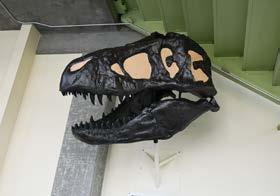
Mold of a Tyrannosaurus rex fossil on display at the entrance of the Earth and Physical Sciences building. (Julia Heron-Watts / Aggie) and Physical Sciences building.
UC Davis has a diverse collection of real fossils, including the saber tooth cat fossil displayed alongside the Tyrannosaurus rex skull. However, big or unusual fossils, particularly real ones (not cast ones) can be expensive and difcult to acquire. Tere are people who make casts of fossils and these casts are often more easily attainable and afordable.
“Sometimes with things like dinosaurs, it’s hard to get a real Tyrannosaurus rex head, particularly in good condition,” Gold said. “It would probably be many millions of dollars and you don’t fnd dinosaurs out in California. During the time
that his child was “killed” by the “woke mind virus” after she transitioned. In the same interview, he described gender-reassignment surgery as “child mutilation and sterilization.”
“At this point, I’ve watched the show all the way through more than fve times, and I fnd that I learn something diferent about it each time,” De Silva said. “Mostly it’s about how diferent my opinions are from them, and how, even if I feel like I align with their beliefs, I’m not in the stage of my life where I want to engage with sex and dating in the way that they do.”
While some episodes have aged poorly in this day and age, the show’s boldness in covering taboo topics remains an incentive to watch.
Tis show defnitely took a risk at the time it was created,” De Silva said. “Shows nowadays portray sex in more explicit ways, which was something this show never had to do even to make a strong impact. I think we rely too heavily on the shock factor of sex nowadays, and we should try to make shows more nuanced like ‘Sex and the City.’”
Though it was released nearly three decades ago, “Sex and the City” remains an important piece of media for all women, having broken the “forbidden” world of sex in media through empowering strong female lead perspectives.
Te early 2000s was the perfect time to start shaping the idea that sex doesn’t have to be a scandalous secret,” Resto said. “Even though sex is more normalized in the media now, the center and allure of this show is the emotional bonds between the women, not the sex.”
If either of these students’ experiences sound interesting, or maybe you just want to see why Big is moving to Paris (if you know, you know), you can watch “Sex and the City” on Netfix and HBO Max.
Sisters Lilly and Lana Wachowski wrote and directed “Te Matrix” and “Cloud Atlas.”
Despite transgender people’s contributions and importance in society, students at UC Davis and beyond feel that their importance hasn’t been properly recognized by either political party.
“I have an issue with the Democratic party because they don’t take any stances with anything,” Baker said. “Tey’re not liberal but more conservative in that they pander to the center-left and moderates. [America] is a very conservative country no matter who is in ofce.”
Baker continued by discussing that the left side of the political spectrum often settles for less active policies to avoid being considered too radical.
“Tey pander towards the moderate conservative because they don’t want to be that far left,” Baker said. “It’s less about their morals and what’s going to get them the most votes. I fear that liberalism is not an accurate way to defne the Democratic party.”
With the establishment of Elon Musk as the head of the Department of Government Efciency (DOGE), many important organizations and initiatives are being cut of under the pretense of streamlining government spending, including Diversity, Equity and Inclusion initiatives.
“I think [DOGE] is a very unconstitutional creation and is giving authority to someone who wasn’t elected,” Baker said.
“[It’s] giving them access to our private information.”
Musk has been outspoken about anti-transgender ideas and, during an interview with Jordan Peterson, claimed
“ T e court has blocked [some] things, but I think that the fact that Elon Musk can have so much authority despite not being elected but simply because he has money points towards how oligarchical our country is becoming,” Baker said. Regarding Trump’s appointment of colleagues to important roles such as Pete Hegseth, a television presenter for Fox News and former ofcer of the National Guard, who has held no previous political ofce, as the U.S. secretary of defense, students also shared their grievances.
“It’s a combination of distaste and disappointment,” Henkel said. “I would expect better from the world and government.I would expect better from the people who are making decisions for millions of people. [It’s] the rise of an era of utter anti-intellectualism and it’s so stupid.”
Despite modern legislation seeking to limit their rights and minimize their societal contributions, transgender individuals have been an integral part of society for centuries. UC Davis students have shared not only the contributions but also the important role that transgender people have played and continue to play in communities all over the world.
It routinely takes over two hours, and is done from around 4:30 a.m. to 6:45 a.m.
Aside from Davis, the monks visit other universities in the general area to spread their message.
“We go to Sacramento State [University], and we go to practically all the universities in the Bay Area, UC Berkeley,” Das said. “We distribute literatures, and we also do what’s known as Harinam, which is public kirtan.”
Kirtan is a form of singing meditation, which they do every day starting at around 6:45 a.m.
Students are welcome to visit every day or attend the Wisdom Talks weekly. Te monks hope to educate UC Davis students about their practice and way of life, and for more information on the group and their upcoming events, anyone interested can visit their Instagram page, @ wisdomtalks.davis.
Gen Z grew up on the internet, and their humor refects that. Tey send each other videos of people falling down and call it bonding. Wipeout was essentially the live-action version of that. Te show walked so TikTok fails could eventually run. Even though the show technically ended in 2014 (before making a comeback in 2021), its infuence never really died. Why? Because, according to students, it was tailor-made for meme culture. Te exaggerated sound efects, the slow-motion replays, the contestants getting absolutely destroyed — it seemed to be the perfect recipe for internet gold.
Anna Bronstein, a fourth-year psychology major, said that “Wipeout” played a large role in shaping her sense of humor. Growing up, she found endless entertainment in watching contestants get smacked of platforms and sent fying into water, all while the hosts delivered hilariously unfltered commentary.
“Tat show was so funny,” Bronstein said. “Te hosts would say the most out-of-pocket things and
dinosaurs were alive, this was all underwater so you’d get marine life from those deposits.”
Additionally, the beginnings of an upcoming display showcasing the history of life can be seen in the hallways of the Earth and Physical Sciences building. It will start with a display on microbiolates, currently incomplete, and continue down the hallway to eventually showcase life evolving.
For those interested in learning more about the fossil collection, check out the UC Davis fossil collection’s website.
the contestants’ reactions just made it even better. Nothing was funnier than watching them swim back to the start of the obstacles so they could get knocked of again. I swear I think that’s why I’m so funny now, it’s because of that show.”
Emily Tyryshkin, a fourth-year biological sciences major, said that watching “Wipeout” with her family makes up a lot of her core memories. Even though the show was full of ridiculous crash-outs and stunts, it was the shared excitement and laughter that made it unforgettable for her.
“I remember watching ‘Wipeout’ with my family all the time when I was younger,” Tyryshkin said. “It was like our thing after dinner. We would always try to guess who would wipe out next, and we’d be dying laughing when someone fell into the water. We would get really competitive about it too. When the [episode] started, we would all pick a person to root for, and I would get so hyped when the person I chose would win.”
At the end of the day, to Gen Z, “Wipeout” wasn’t just a game show, it was a cultural event. It was a right of passage. It was a reminder that sometimes life will smack you in the face with a giant foam mallet, and you just have to get up and keep going. So here’s to “Wipeout” — seemingly one of the greatest shows ever made about falling down and getting back up. Who knows? Maybe one day it will get revived again; Until then, members of Gen Z at UC Davis and beyond await the day.
“[Rest in peace], ‘Wipeout’ — a fallen soldier,” Regev said.
Layla Abedini, a second-year biological sciences major, attended the show and expressed her excitement about what Nineteenth Operator has in store.
“Tey both have really good stage presence and beautiful voices,” Abedini said. “Tey sound great together. I’d defnitely want to see them perform again.”
Teir frst single, “Crazy Ex Girlfriend,” will be released on Feb. 28. To stay up to date with Nineteenth Operator’s shows and song releases, fans can follow them on Instagram, @ nineteenthoperator.
Miller led in scoring with four goals, while Massman and Tempel had three each.
On Jan. 9, the Aggies beat Santa Clara University 17-6, winning three in a row at their home tournament and bringing their overall record to 8-5.
Te results of the Aggie Invite boded well for the team’s season. Te UC Davis women’s water polo team will aim to maintain the streak when Big West Conference play begins against UC San Diego on March 1.

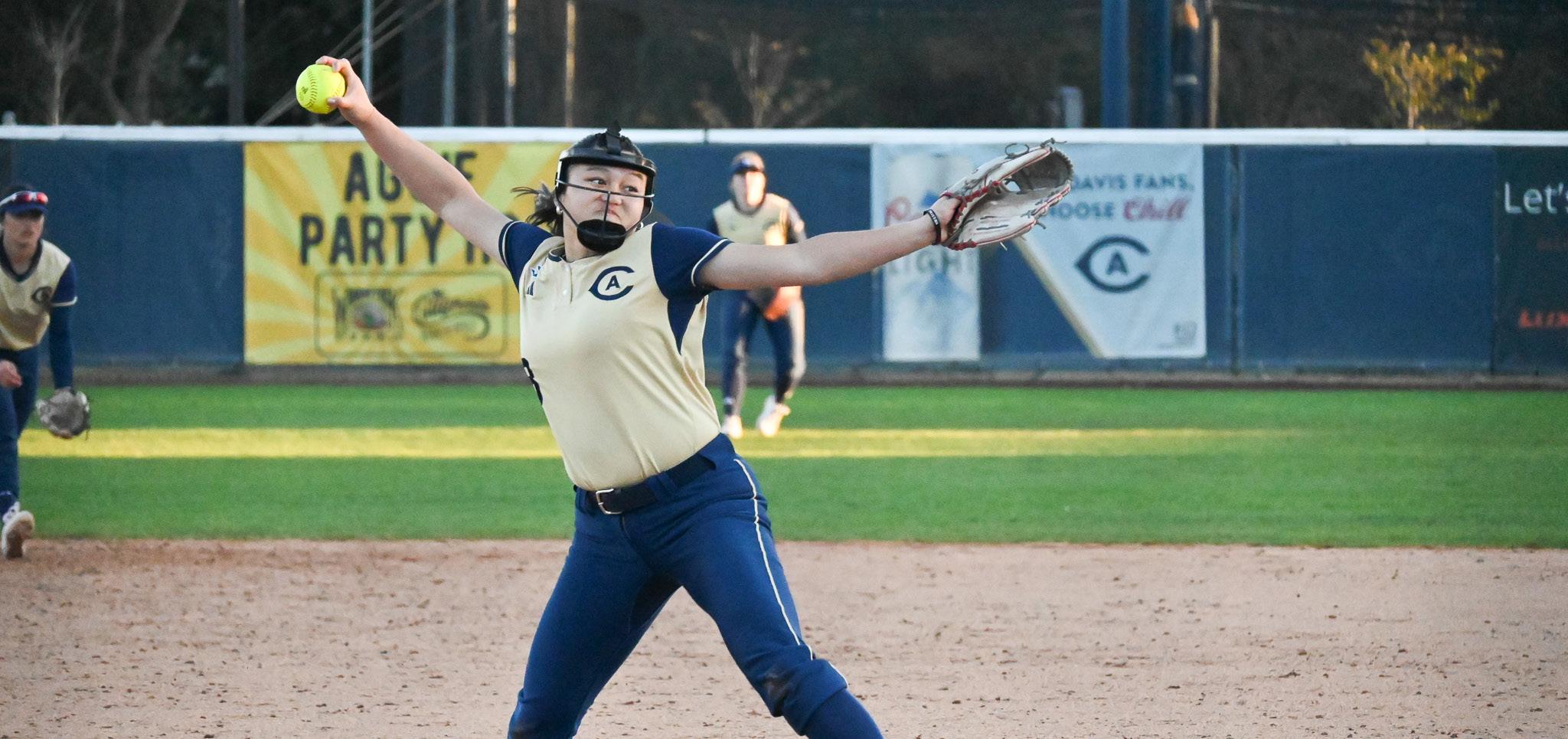
UC Davis softball team hits off the 2025 season at the NorCal Kickoff tournament
The Aggies finish 3-1, propelled by dominant pitching performances
BY THEO KAYSER sports@theaggie.org
Te UC Davis Aggies’ softball team started of their season on Feb. 7, playing the frst of four eventual games over the weekend’s 2025 NorCal Kickof tournament on La Rue Field.
Te season was set to begin a day earlier, on Feb. 6, but both games of the Aggies’ double-header that day were rained out.
“[Te] team had a goal to] be adaptable, [...] and it was perfect timing,” Bella Holtz, a fourth-year mathematical analytics and operations major, said. “We told ourselves we weren’t gonna let [the rainouts] kill our vibe.”
Achieving their goal, the Aggies started the season of strong, winning three of their four games in the tournament.
UC Davis’ frst game was against Utah Valley University on Friday, Feb. 7. Te Aggies won by a score of 3-0, led by dominant pitching performances from Caroline Grimes, a fourth-year managerial economics major, and second-year Ashley Sawai. Grimes started the game and tossed 4.1 scoreless innings, allowing just three hits and no walks. Sawai closed the game, earning a save for her 2.2 clean innings.
Te Aggies’ ofense in this frst game was led by Grace Kilday, a fourthyear undeclared major, who opened the scoring with a runs batted in (RBI)
WOMEN’S LACROSSE
triple and went on to reach base in two of her three plate appearances. Firstyear Alyssa Dethlefson and Marley Panziera, a second-year viticulture and enology major, also had excellent performances, with Dethlefson recording hits in all three of her at-bats and Panziera going 2-3.
Te Aggies’ second game went strikingly similarly to their frst: another 3-0 victory, this time over San José State University. Sawai continued her dominance on the mound, pitching a complete game shutout with a fnal line of seven innings, eight strikeouts and just two hits. Panziera once again led the Aggies’ lineup, driving in two of the Aggies’ three runs in the game.
On Feb. 9, UC Davis played a double-header, facing of against Boise State University at 12 p.m. and Saint Mary’s College of California at 2:30 p.m.
Te former of the two games saw the Aggies take the frst loss of their season in blowout fashion, losing 155. Te game was called after just fve innings. UC Davis faced little chance of victory given Boise State’s ofensive surge, but the Aggies did have their highest run total of the tournament in this game. Panziera continued her dominant tournament, recording another two hits to go with three more RBIs. Tird-year Mickey Buscemi joined Panziera, going 2-3 with two RBIs of her own.
Te tournament concluded for the Aggies later that afternoon in a 2-1
victory over Saint Mary’s. UC Davis’ pitching staf bounced back from their previous game, led by yet another masterful outing from Sawai. She recorded her second complete game of the tournament, with eight more strikeouts and just one unearned run. Ofensively, the Aggies sputtered early, recording zero runs across the frst fve innings. In the sixth, however, they broke into the scoring column after a dramatic two-run and pinch-hit single by frst-year Claire Shelton.
Te weekend for the Aggies was an unquestionable success, as they begin their season with a strong record of 3-1. Tey were led by several dominant pitching performances, as in all three of the Aggies’ wins, they allowed no more than one run. Across the weekend, the Aggies deployed just three diferent pitchers, a remarkable feat of stamina with Grimes and Sawai in particular pitching on short rest.
Holtz said that the team’s pitching staf consists of “quality over quantity,” showing just how crucial these players are for the team. Across the tournament, Sawai stood out in particular, as she tossed 16 and two-thirds innings with zero earned runs, 18 strikeouts, two wins and a save.
Te Aggies will continue their season on Feb. 14, when they will begin their second tournament of the season at the Cardinal Classic in Palo Alto, California.
UC Davis lacrosse falls to UC Berkeley in home opener
Two last-minute goals for the Golden Bears clinched their victory
BY
LUCIENNE BROOKER sports@theaggie.org
It was a long of-season for UC Davis Aggies’ lacrosse fans as they awaited the return of both their men’s and women’s teams to the UC Davis Health Stadium. After an early loss in the 2024 Pac-12 Tournament to highly ranked University of Colorado, Boulder, the women’s lacrosse team had 10 months to regroup and rebuild in preparation for the 2025 season.
Tey kicked of on the road, traveling to San Rafael, California to face the Dominican University of California Penguins. Tey defeated the Penguins 21-7 and came back
to Davis for their frst home game on Feb. 8 against the UC Berkeley Golden Bears.
Te game against the Golden Bears was a day of celebration. After a week of rain, the sun came out just in time for the game, and the Aggies celebrated Alumni Day and Junior Aggie Day. Despite the loss, spirits were high amongst alumni, children and the rest of the crowd as the players put up a strong fght against a highly rated team.
A review of the UC Davis men’s and women’s tennis matches from Feb. 7 to 9
BY DIEGO CERNA sports@theaggie.org
Over the weekend of Feb. 7 to 9, the UC Davis men’s and women’s tennis teams faced of against teams across Te Big West away from home. On Feb. 8, the UC Davis women’s team faced the University of the Pacifc Tigers in Stockton, California. Tey won six total singles and doubles matches fairly swiftly, grabbing a 6-1 victory. Te matches between UC Davis and the University of the Pacifc began with the doubles matches. Playing frst and second, respectively, doubles pair Daisy Maunupau, a fourth-year cognitive science major, and Solia Valentine, a student in the UC Davis Graduate School of Management, and doubles pair Mika Ikemori, a secondyear psychology major, and Polina Marakhtanova, a frst-year cognitive science major, were unable to defeat their opponents. Claire Galerkin, a fourth-year managerial economics major, and Kaia Wolfe, a third-year aerospace science and mechanical engineering double major, were the only UC Davis duo to scrape out a win with a score of 6-3. Despite this, the Tigers’ win of two out of three matches allowed them to take the early lead, starting with a 1-0 overall win score against the UC Davis Aggies. Fortunately, every singles player was able to get the job done in their matches, all completed in a total of two sets. Valentine started the Aggies of with a win of 6-2 in the frst set and a closeout of 7-6 in the second, holding of her opponent from claiming the victory.
Marakhtanova and Penelope Wong, a frst-year environmental engineering major, claimed a strong victory and secured the frst wins of their collegiate careers. Other single victories included Maya Youssef, a third-year political science major, along with Wolfe and Galerkin who previously won in the doubles bracket. Tis pushed the Aggie women’s overall record to 2-5. On Feb. 9, the UC Davis men’s team traveled to Moraga, California to take on the Saint Mary’s College of California Gaels. In this matchup, contrary to the women’s team, the Aggies were able to obtain both
team was able to score until over halfway through the time period. Tey traded goals, each scoring three, but the Aggies were able to maintain their advantage until the very last seconds.
UC Berkeley was fnally able to tie the score on a shot from their very own Courtney Wong with only three seconds to go.
doubles points and singles points in matches throughout the day.
Sam De Vries, a fourth-year communications major, and Rithvik Katpelly, a frst-year undeclared major, began with a swift 6-2 victory over their opponents to put the Aggies on the board.
Lucas Bollinger, a third-year economics major, and Kaveh Taheri, a frst-year undeclared major, played after in a close series of sets but ended up losing 4-6, despite a strong performance.
Te doubles bracket came down to Ivan Savkin, a second-year computer science major, and Ryan Torres, a fourth-year neurology, physiology and behavior major, in the last set. In the closest match of the doubles portion, Savkin and Torres were able to pull away with a tight 7-5 victory, leaving the Aggies in the lead going into the singles matches.
In the singles bracket, Bollinger was able to beat his opponent in two dominant sets, earning a score of 6-2 in each. Katpelly and Eduardo Gonzalez, a second-year biochemistry and molecular biology major, defeated their opponents in three sets. Overall, the men’s tennis team took away the victory over Saint Mary’s with a fnal score of 4-1.
Te matches against the University of the Pacifc and Saint Mary’s were a successful road outing for both the UC Davis men’s and women’s tennis teams. Te women’s team will hit the road again to face UC San Diego on Feb. 15 and UC Irvine on Feb. 16. Te men’s team is set to face UC Berkeley on Feb. 15 and Santa Clara University on Feb. 21. As the season progresses, both teams will aim to provide even stronger performances and continue to build momentum.
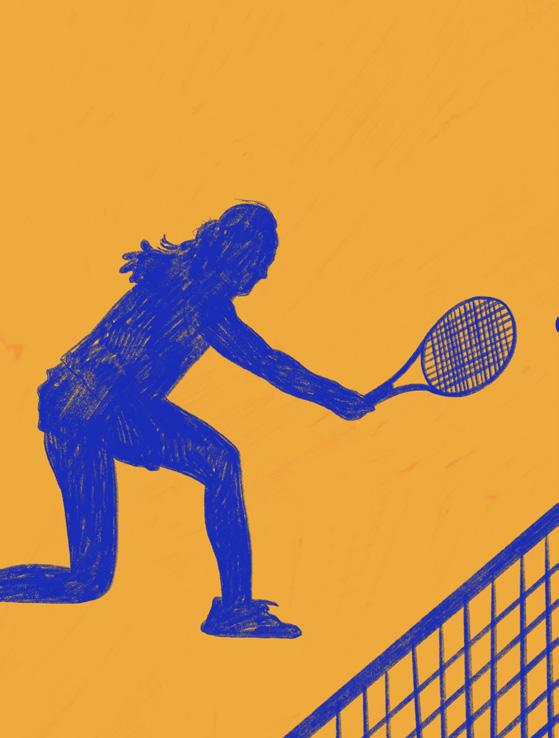
frst-year attacker, in her collegiate debut. Although the Golden Bears responded with two more goals of their own, starting to create a lopsided score, this scoring streak prompted the Aggies to start one of their own.
Another goal from Fox kicked of an impressive run. Reese Loseke, a third-year environmental policy analysis and planning major and attacker, also converted two goals, tying the score. Finally, with 12 seconds remaining in the frst quarter, Natalie Markman, a fourth-year genetics and genomics major and midfelder, scored an unassisted goal to give the Aggies the lead heading into the break.
Scoring remained equal throughout the third quarter, as each team fought for an advantage. Fox was able to clinch a hat-trick. However, it was the lowest-scoring quarter of the game. Both teams were held to two goals, a testament to strong defending and goalkeeping by each side. As the score stayed tied at 10-10 heading into the fnal quarter, the intensity and pressure mounted.
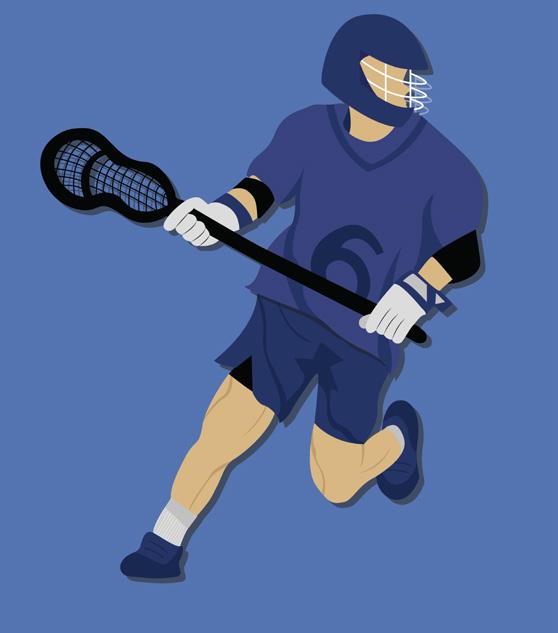
own, they were unable to use the last 20 seconds to tie the game and ended in a narrow loss with a fnal score of 15-14.
UC Berkeley came out swinging, scoring three goals to the Aggies’ one. However, the contest wasn’t over. UC Davis cut the defcit to one point with seven minutes remaining on the clock. Despite this renewed efort, the Golden Bears put away two more goals, increasing their lead to three points again. Although the Aggies scored two last-minute goals of their
In the second quarter, neither
Next up, the Aggies go on the road for two matches against formidable opponents. Tey will take on Stanford University on Feb. 15 and the University of Southern California on Feb. 21, before coming home for a stretch of home games as the post-season tournament approaches. Tese matches serve as a warm-up for the inaugural Big 12 Conference Championship tournament.
Aggies shutout UC Merced, dominating in the second game of the Aggie Invite
The 21-0 victory demonstrated the Aggies’ skills on both ends of the pool
BY COLINA HARVEY sports@theaggie.org
Te UC Davis women’s water polo team dove into their season with a series of tournaments before entering the Big West Conference play.
Te team has participated in the Arizona State University (ASU) Cross Conference Challenge, the California Cup, and the Triton Invitational, felding mixed results. While they had a strong start, going 3-1 in the ASU tournament, they faced two losses to UC Los Angeles and Stanford University in the Cal Cup. Ten, at the Triton Invitational, they beat Loyola Marymount University and Fresno State University in close games, eventually falling to the University of Southern California
UC Berkeley found the back of the net frst, with two quick goals scored only minutes apart at the start of the game. However, the Aggies fought back quickly. Te frst home goal of the season was scored by Jane Fox, a and Long Beach State University. On Feb. 8 and 9, the team hosted the Aggie Invite at their very own Schaal Aquatics Center. Tey faced the University of the Pacifc, UC Merced and Santa Clara University. Going into the weekend, the Aggies looked to improve their 5-5 record.
After beating University of the Pacifc 15-10, UC Davis took on the UC Merced Bobcats just a few hours later, hoping to continue to dominate at home.
Te Aggies controlled the sprint in the frst quarter and UC Davis’ Bridget Miller, a second-year undeclared major and center, quickly turned the frst possession into a goal. UC Merced took the ball to the other end and got a shot of, but it was blocked by the Aggies’ keeper. On the next play, the Aggies drew
a fve-meter penalty, which Gianna Nocetti, a third-year mechanical engineering major and attacker, successfully converted. Within a minute, the Aggies had amassed a quick 2-0 lead.
Strong Aggie defense forced the Bobcats to take riskier shots, making it difcult for UC Merced to score.
After a close-in goal by Miller with about fve minutes left in the quarter, UC Merced blocked two consecutive Aggie shots and seemed to be gaining some defensive momentum. However, UC Merced then turned over the ball, leading to the Aggies’ fourth goal, the frst for Liberty Massman, a thirdyear human development major and center.
Te Aggies ended the quarter with another goal from Massman, as well as a last-minute goal in the top left corner
from frst-year Margo Tempel. Going into the second quarter, the Aggies led by six and had yet to concede a goal. Te second quarter saw the Aggies dominate even further with a barrage of shots with multiple long balls from the keeper which led to open goals for the Aggies. Early in the quarter, the Aggies were able to score of of a power play. Ten, on the other end, they were able to defend a UC Merced power play, continuing the shutout. UC Davis’ strong passing skills shined with smooth assists leading to unguarded shots. In the last four minutes of the quarter, the Bobcats could not stop the Aggies’ ofense, allowing UC Davis to score seven times. Tis brought the halftime score to 16-0. Te Aggies continued their domination throughout
the second half. UC Davis’ strong defense stood out as it did not allow any easy shots for UC Merced. In the third quarter, the Aggies added three goals to their total, one of which was a penalty scored by Miller.
In the fourth quarter, the Aggies controlled the sprint, as they had every quarter so far. In an impressive late game play, Chelsea Johnson, a secondyear undeclared major and center defender, caught a pass near the goal, turning and shooting the ball into the net with one motion. A goal with less than two minutes left in the game capped of the Aggie scoring, ending the game with a score of 21-0. While UC Merced hit the post on the last possession of the game, they weren’t able to net any goals.